E.G. Wolverson's Blog, page 11
September 12, 2015
Time War II | 1984 vs 2007 vs 2010: The Transformers’ War for Cybertron

You’d probably be surprised at just how many transformations Hasbro’s foremost franchise has gone through on screen. Those in my age group can’t fail to remembers Sunbow Productions’ iconic Saturday-morning syndicated cartoon, The Transformers, while younger viewers have no doubt been wowed by the spectacle of Michael Bay’s epic Transformers movie quadrilogy, or found themselves enraptured by the CG beauty and epic storytelling of The Hub’s Transformers: Prime. In between, though, there have been countless reimaginings and reinterpretations of the Cybertronians, ranging from ill-fated and rushed Japanese efforts to American attempts to please all (and thus none), and even a highly popular though initially quite radical extension of the “robots in disguise” precept that was cleverly – and initially very subtly - couched in The Transformers’ continuity. However, I don’t think that anyone but the most hardened Beast Wars adepts would argue with the fact that The Transformers (or “Generation One”, if you will), Bay’s blockbusters and Transformers: Prime are the franchise’s best known and most widely loved on-screen expressions, and so it is these three combaticons that will wage a war for Cybertron in this, the second of the great time wars.

The 1980s Generation One (“G1”) cartoon was one of the first series to take advantage of the then-recent relaxing of product-placement laws in the US. It’s easy to be critical of a show that’s episodes are admittedly little more than elongated toy commercials, but it’s important to remember that without G1, Transformers were just imported and rebranded Takara toys with a hell of a gimmick, but absolutely no context for it. Without the G1 stories, and without the lore that grew out of them, I dare say that Hasbro’s Transformers toys wouldn’t have made it out of the 1980s.

In fact, the G1 programme did a wonderful job of taking these groundbreaking Japanese toys – toys that were vehicles, toys that were action figures, toys that were little engineering puzzles… all at once – and turning them into unforgettable characters. Who could forget the calm, no-nonsense nobility of Optimus Prime, the leader of the Autobots? Or the incessant antagonism between the megalomaniac Decepticon leader, Megatron, and his all-too ambitious underling, Starscream? Grizzly “Arn-hahhhd”, friendly “every ’bot” Bumblebee, enthusiastic Jazz, irreverent Ratchet, impetuous Hot Rod, sinister Soundwave – all these inanimate lumps of plastic and die-cast metal were imbued with larger-than-life personalities via the G1 cartoon; personalities that would prove strong enough and malleable enough to survive across generations.

The G1 characters’ back story was inspired too, and like its characters would continue across innumerable interpretations, becoming ever more refined and elaborate with each ensuing incarnation as new writers would embellish and expound upon its successful elements while dexterously ignoring, or even overwriting, the rest. The G1 series’ opening three-part mini-series, retroactively subtitled “More Than Meets the Eye”, brought the Autobots and the Decepticons to Earth where they would resume the civil war that had left their homeworld of Cybertron depleted of energy (well, energon). This time, though, they would wage it covertly, using their innate powers of transformation to disguise themselves as Earth vehicles, creatures or technology. I remember thinking as a child that every car I saw might be a heroic Autobot; every overflying plane could be an evil Decepticon. It’s a thrilling fusion of the mundane and the dangerous, and one that continues to work today. But as the series unfolded, its tapestry would become more intricate and interesting, as through episodes such as David Wise’s outstanding “War Dawn”; The Transformers: The Movie; and much of the envelope-pushing third season, the programme would delve deeper into the characters’ and Cybertron’s history, laying solid mythological foundations for future movies and series to build upon.

However, much of G1 doesn’t hold up to close scrutiny. Particularly once we’re into its second season, our supposed robots in disguise are quite the celebrities on planet Earth – if they aren’t taking part in automobile races, they’re helping out a beleaguered mayor or forming security details for any old scientist with a half-decent invention that Megatron might take a fancy to. Not only does this make a mockery of the toys’ “Robots in Disguise” tagline, but it beggars belief that humanity would welcome the alien Autobots with such open arms when their Decepticon cousins are household names for all the wrong reasons. Fair dues, the three-part “Megatron’s Master Plan” would see humanity briefly turning against the Autobots, but only whilst wilfully siding with the ’Cons. Say what you will about the Michael Bay movies, but the xenophobia brought to the fore in Age of Extinction, especially, is much more credible.

Until the 1986 movie, the “More Than Meets the Eye” motto was debased too. In fact, it was often more a case of “Just What Meets the Eye” as there was no depth to anything. Part of this is attributable to when the show was made; you’ll be hard-pressed to find a children’s animated series from the same era that doesn’t underestimate its audience on the most fundamental of levels. Mostly though, it was down to overcrowding, as Hasbro did their level best to shoehorn as many ’bots into each instalment as they possibly could, causing no end of storytelling problems as a result.

In most fiction, and indeed most subsequent Transformers fiction, the villains outnumber the heroes. We have a tendency to root for underdogs, and it’s pretty much a given within the genre that villains are supposed to spend two-thirds of a story almost achieving their evil ends through sheer might / strength of numbers, only to be foiled by the heroes’ ingenuity or heroism in the story’s final act. Not so in G1 – by the end of the second season, there were apparently a bazillion Autobots on Earth under Optimus Prime’s command. I recall one early episode in which Jazz conducts an Autobot roll call and it takes him about five minutes, and that was before the ranks started to swell in Season 2. To make matters worse, the Decepticons’ often-cited aerial superiority is purely imaginary in G1 – even before the Autobots had constructed the Aerialbots, enlisted Powerglide and turned Skyfire to their cause, they were flying about in their robot forms, battling with the ’Cons in the skies on a level pegging.

Given the above, the vast majority of the G1 characters were not even worthy of being called ciphers in the first two seasons. Perceptor might interject in a story for thirty seconds just to remind everyone that he can transform into a microscope, should one be required, and then vanish for the rest of it. Hoist might have gone to Hollywood, but his character never changed or developed as a result of his trip; almost every damned show ended with a press of the reset button. Powerglide might have fallen in love, but outside his twenty-two minutes of fame he was just one of many ’bots crowding the screen yelling, “Buy me!” Even the heavy-hitters such as Optimus Prime and Megatron never developed beyond their well-drawn initial portrayals. They were both great, iconic characters, and Peter Cullen and Frank Welker’s performances would help to make them legends, but – outside the cinema, anyway – little ever happened to either that would carry any weight from one story to the next.

As the 1986 movie loomed, however, the tide began to turn - the end of the second season would see Starscream finally turn his back on his master in an against-the-grain two-episode arc. The reset button might still have pressed again at the end of “Revenge of Bruticus”, its concluding instalment, but it would still set the stall beautifully for The Transformers: The Movie, in which the treacherous jet would finally get to toss his master’s moribund body into space.

“I… still… function…” / “Wanna bet?”
The revamped third season did improve things somewhat, focusing largely on Rodimus Prime’s inner circle (Ultra Magnus, Kup, Arcee, Springer and Grimlock) within the Autobot camp, and just Galvatron and his two air generals (Cyclonus and Scourge) on the dark side. This allowed for much greater character exposure, if not development per se, though we would see the sparks of a subtle romance blossom between Arcee and Springer, as well as witness Rodimus wrestle uneasily with the mantle of Autobot leader across a number of episodes. The latter is especially interesting when you consider the weight of prophecy on the former Hot Rod’s shoulders - the dying Optimus Prime spoke of the Autobot who would rise from the ranks to claim the Matrix of Leadership and use it to “light their darkest hour” with the sort of reverence that made you think this new leader would be - quite literally - the stuff of legend, so it’s a surprising but nonetheless welcome development when he turns out to be plagued with self-doubt and overcast by Optimus’s shadow.

Other characters would be stretched too, and some of them quite unlikely candidates. Octane, a little known Decepticon triple-changer, runs an energon scam in the Middle East and as a result is thrown out of the posse by Galvatron, who then puts a price on his head, causing his defection to the Autobots. Spread across several episodes, the Octane arc was marred only by networks’ shambolic inability to broadcast the episodes in the correct order. As transmitted, Octane starts off on the run from the ’Cons!

The final flaw of G1 is its poor human characters, who are just about as far from remarkable or even relatable as you could possibly get. I think on some level this was recognised within the production office, as the second season continually introduced new human protagonists in the hope that some would stick, but in the end only Spike Witwicky and his future wife Carly would make it through to the movie, by which time they’d had a son and Spike had learned a bad word. Even Season 3 couldn’t turn things around on this front, with more inane humans appearing on an almost weekly basis (even one called Dirk).

“All we need is a little energon, and a lot of luck.”
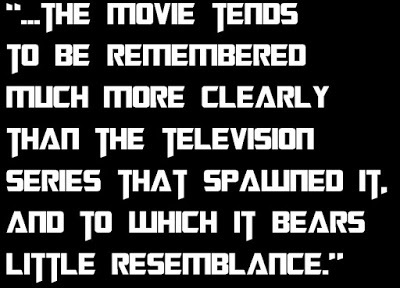 G1 is ultimately saved, though, by the genius of The Transformers: The Movie, which, despite its divisive content and box office failure, has to be regarded as one of the boldest tie-in movies of all time. It’s actually a misnomer to use the “G1” retronym when discussing the film as it’s an elaborate changing of the guard from the first generation of Transformers (the 1984 and ’85 toylines…) to the 21st-century generation of Transformers (the incoming 1986 toyline). Whilst clearly driven by marketing, the mass exodus of ’bots allowed Ron Friedman and Flint Dille to do something truly shocking by slaughtering almost all of the audience’s most beloved Autobots within the space of just a few scenes – Optimus Prime amongst them. The inevitable dark tone, coupled with the weighty performances of actors the calibre of Leonard Nimoy and Orson Welles (in his finale role) and a scintillating synth-metal soundtrack sets the film completely apart from the episodes sat either side of it. This is quite ironic, really, when the movie tends to be remembered much more clearly than the television series that spawned it, and to which it bears little resemblance.
G1 is ultimately saved, though, by the genius of The Transformers: The Movie, which, despite its divisive content and box office failure, has to be regarded as one of the boldest tie-in movies of all time. It’s actually a misnomer to use the “G1” retronym when discussing the film as it’s an elaborate changing of the guard from the first generation of Transformers (the 1984 and ’85 toylines…) to the 21st-century generation of Transformers (the incoming 1986 toyline). Whilst clearly driven by marketing, the mass exodus of ’bots allowed Ron Friedman and Flint Dille to do something truly shocking by slaughtering almost all of the audience’s most beloved Autobots within the space of just a few scenes – Optimus Prime amongst them. The inevitable dark tone, coupled with the weighty performances of actors the calibre of Leonard Nimoy and Orson Welles (in his finale role) and a scintillating synth-metal soundtrack sets the film completely apart from the episodes sat either side of it. This is quite ironic, really, when the movie tends to be remembered much more clearly than the television series that spawned it, and to which it bears little resemblance. 
“One shall stand. One shall fall.”
The movie’s first twenty minutes or so, in my view, are matchless. They represent to me what the G1 cartoon always should have been – high stakes and explosive action carried by characters that we care about. The film didn’t need the constant, irritatingly high-tempo incidental music of the television series to engender a false sense of urgency – here, the script and performances would have been enough by themselves, but scored with a few metal tracks the result is nothing short of epic. The movie’s opening has an oddly climactic feel to it, like a season finale, culminating in the Decepticon attack on Autobot City and Optimus Prime’s final stand against Megatron.

“You who lives without mercy, now asks for it?
I thought you were made of sterner stuff.”
Optimus’s death is handled with remarkable poise on every front – it’s even believable that he could be mortally wounded by Megatron, who’d never come all that close to doing so before, due to the interference of Hot Rod, on whom the plot would then turn. What stands out the most about it though is the writers’ refusal to pull their punches – we don’t just see Optimus wounded and gently fade out; we hear him rattle out a throaty death-bed speech as he nominates Ultra Magnus as his successor before decomposing, his once bright reds and blues fading to charcoal as a drum tolls with the same efficacy as a funeral bell. Had the rest of G1 been half as good as half of this movie, then it would be the hands-down winner of this time war.

“Until the day… Until all are one.”
Whilst the last hour of the film is very good, it feels more like a season-opening, contrived, cliffhanger-resolving episode hastily written over a summer hiatus. It lacks the weight of the movie’s opening, and is marred by some bizarre – but nonetheless memorable – sequences, such as the bizarre “Dare to Stupid” skit on Junkion. What carries it is Hot Rod’s journey from troubled hothead to Autobot leader – arguably the only meaningful character journey that any G1 Transformer would ever go on.

But of course, if you punch “transformers movie” into a search engine today, the top results returned don’t relate to the 1986 cult classic, but Paramount Pictures’ live-action film series directed by Michael Bay and comprising Transformers (2007); Transformers: Revenge of the Fallen (2009); Transformers: Dark of the Moon (2011); and, most recently, Transformers: Age of Extinction (2014). These are the films that have made Transformers household names again, grossing almost four billion dollars between them in spite of widespread negative reviews and even many claims of, “Michael Bay ruined my childhood!”

Whilst Bay’s inability to travel back in time should see such claims dismissed out of hand, such backlash is to be expected when you consider that his movies deliberately set out to be everything that the G1 show was not. Colourful cartoon characters for kids would become intricately-rendered, photo-real and often quite terrifying CG robots that are as redolent as something you might see in one of James Cameron’s chilling Terminator movies as they are anything from G1. Forgettable, two-dimensional human companions would make way for troubled teens, arsehole agents and even spirited soldiers to whom there really would be more than meets the eye, and to whom an audience could gravitate. Even the Transformers’ mythology would be expanded and enriched by Alex Kurtzman and Roberto Orci’s wonderfully selective screenplays, which took their inspiration as much from the highly-regarded Transformers comic books as they did G1. Abounding with scantily-clad young women, cursing robots (insults like “dickhead” and “wanker” are even jovially thrown about by Autobots in Dark of the Moon, really putting Spike’s one-off expletive in The Transformers: The Movie into perspective) and action so real and engrossing that watching it is more like being on a rollercoaster than sat in a cinema, Bay’s movies might not be a G1 fan’s wet dream, but there’s no denying their mass-market appeal.

Being a fan of gritty realism in all things, I love the look of the silver-screen Transformers, particularly the Autobots who tend to still be clearly identifiable despite the major changes in their appearances since G1. The decision to make Bumblebee a Camaro instead of a Volkswagen Beetle was a no-brainer, given the film’s tone and style, and whilst making Optimus Prime a flame-tattooed, long-nosed truck cab instead of an unassuming flat-nose wasn’t such an obvious choice, the more that I’ve seen it, the more I like it; I just wish that they’d have stayed closer to the G1 colour scheme. Losing his trailer for the first couple of movies was also a change that I welcomed - it used to irritate me no end that it would magically vanish into the aether whenever he would convert into his robot form in G1. Ironhide has never looked better than in this incarnation either, his GMC pickup truck vehicle mode giving the weapons specialist the fearsome finish his G1 red Nissan Vanette could only have dreamed of. Even Ratchet, whilst unrecognisable from G1 here, actually passes for an American ambulance (rather than a Japanese one) when in disguise, which makes far more sense.

By the same token, making Megatron’s alternative mode a Cybertronian jet rather than a pocket-sized gun is one of the best decisions made in the history of Transformers. Even as a child, I’d be perplexed at how this giant robot could condense himself into a small hand-gun, and as an adult I’d wonder why this great Decepticon gladiator would choose to mass-shift into a comparatively tiny weapon that would be ultimately wielded by another. Both issues are put paid to by Bay’s movies, which would turn ineffectual cartoon villains into absolutely terrifying technological terrors – if largely faceless ones.

Indeed, for all that sets them apart from G1, the live-action movies are often tripped up by one of the same major problems, though here its cause is rather different. Beyond Optimus Prime and Bumblebee, one or both of whom prop up each instalment of the saga, few of the Transformers are really fleshed out as rounded characters, and even fewer grow or change. Exceptions are made for the likes of Leonard Nimoy’s Sentinel Prime and, to a lesser extent, Mark Ryan’s ( Robin of Sherwood ) Jetfire and Hugo Weaving’s Megatron, but as a rule the main Autobots and Decepticons generally only get one or two big “hero moments” or “villain moments” in each film, and even these inevitably pander to the characteristics that you’ll find etched on the back of their toys’ boxes rather than taking them anywhere new (other than destruction, that is, in most cases). This is at least a little more palatable this time around, though, as the root cause isn’t as much the endless toy parade of G1 as it is the films’ focus on the human protagonists, which is probably their greatest strength beyond special effects.

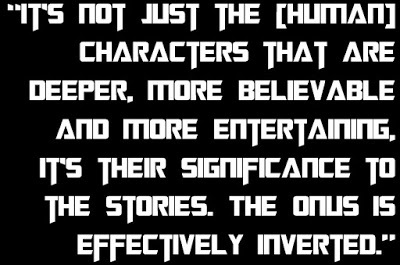 The first trilogy of films are seen through the eyes of young American Sam Witwicky, played by credible everyman Shia LaBeouf. LaBeouf does a splendid job of sucking viewers into his humdrum little world and the tiny problems that it contains, before, inevitably, those problems get a whole lot bigger and he finds the weight of the world on his shoulders. Throughout all three films, LaBeouf gives a performance that’s by turns heroic, emotional and, more often than not, humorous, aided and abetted on the way by uproarious parents (perfectly played by Kevin Dunn and Julie White); stunning lady friends (Megan Fox’s car-thieving Mikaela Banes in the first two movies, Rosie Huntington-Whiteley’s chic Carly in Dark of the Moon); hysterical secret agents (the matchless John Turturro’s Seymour Simmons); and even military might (most notably Josh Duhamel’s Captain William Lennox). Compare that dramatis personae against G1’s Spark Plug, Spike, Carly, Daniel, Chip, Marissa et cetera and note the difference. It’s not just the characters that are deeper, more believable and more entertaining, it’s their significance to the stories. The onus is effectively inverted in these movies.
The first trilogy of films are seen through the eyes of young American Sam Witwicky, played by credible everyman Shia LaBeouf. LaBeouf does a splendid job of sucking viewers into his humdrum little world and the tiny problems that it contains, before, inevitably, those problems get a whole lot bigger and he finds the weight of the world on his shoulders. Throughout all three films, LaBeouf gives a performance that’s by turns heroic, emotional and, more often than not, humorous, aided and abetted on the way by uproarious parents (perfectly played by Kevin Dunn and Julie White); stunning lady friends (Megan Fox’s car-thieving Mikaela Banes in the first two movies, Rosie Huntington-Whiteley’s chic Carly in Dark of the Moon); hysterical secret agents (the matchless John Turturro’s Seymour Simmons); and even military might (most notably Josh Duhamel’s Captain William Lennox). Compare that dramatis personae against G1’s Spark Plug, Spike, Carly, Daniel, Chip, Marissa et cetera and note the difference. It’s not just the characters that are deeper, more believable and more entertaining, it’s their significance to the stories. The onus is effectively inverted in these movies.
Age of Extinction then goes onto introduce us to “Generation Two” of the movie-universe humans, led by Mark Wahlberg’s single father and struggling inventor, Cade Yeager. It’s arguably the most human-driven film of the series to date as, rather than extend the Autobot / Decepticon war into a second trilogy, here the writers use humanity to build a new race of Transformers (enter Galavatron…) from the wreckage of fallen ’bots and then follow their folly through a number of well-played and well-rounded human characters. The movie is also notable for its portrayal of Optimus Prime, who becomes increasingly bitter and disenchanted as the narrative progresses, for the first time in years giving Peter Cullen some heavy material to sink his teeth into. Indeed, despite the pummelling that it’s taken from critics, Age of Extinction is probably the most underrated of the live-action movies.

But I have a fundamental issue with all of the live-action movies, even the brilliant first one, that isn’t as easy to get around as a dearth of ’bot character development. I loved The Transformers most when I was about five years old. These movies are not suitable for that age range. Age of Extinction was rated 12A by the British Board of Film Classification, but there’s stuff in it that disturbs me: one of the human protagonists is graphically immolated, for instance - and not in a cartoon, slightly unreal Revenge of the Sith sort of way. This shit looks real. And so, even if I wanted my daughter to start dropping little jibes like “dickhead” and “wanker” into casual conversation – which, needless to say, I don’t – I still wouldn’t be able to show her these films until she’s far too old to give a damn about them without risking countless sleepless nights. That’s not to utterly condemn them, of course – for me, and for millions of grown-up, popcorn-munching, thrill-seeking cinemagoers the world over, they are truly outstanding movies – just in the wrong genre.

Alex Kurtzman and Roberto Orci’s Emmy Award-winning Transformers: Prime, however, is clearly product of lessons hard-learned. It effortlessly fuses the most successful elements of G1 with the edgier world and designs of the live-action movies and even elements of Beast Wars to create what is, in my view, the ultimate family-friendly Transformers experience.

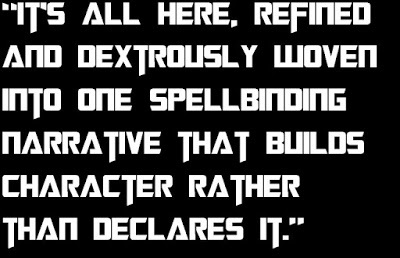 What really stands out about Transformers: Prime right from the outset is the producers’ determination to make a television series, rather than a toy commercial. Indeed, there was even talk of the show not having its own toy line, though thankfully common sense prevailed in the end. The characters are therefore few in number, with the eponymous Team: Prime being limited to Optimus Prime; Ratchet; Bumblebee; Arcee; Cliffjumper; and Bulkhead in the opening mini-series, with only Wheeljack; Smokescreen; and Ultra Magnus joining them as the series progressed. In the purple corner, meanwhile, you’ll only find the classic triumvirate of Megatron; Starscream; and Soundwave in situ at the start, with Knock Out; Breakdown; Skyquake; Dreadwing; Airachnid; and, ultimately, the Predaking joining them en route to the series’ concluding Beast Hunters: Predacons Rising TV movie. The Decepticons’ numbers are made up by legions of identical Vehicons, or “Decepticon Minors”, and Insecticons – ingenious ways to keep the balance of power with the ’Cons without giving the writers too many discrete characters to focus on.
What really stands out about Transformers: Prime right from the outset is the producers’ determination to make a television series, rather than a toy commercial. Indeed, there was even talk of the show not having its own toy line, though thankfully common sense prevailed in the end. The characters are therefore few in number, with the eponymous Team: Prime being limited to Optimus Prime; Ratchet; Bumblebee; Arcee; Cliffjumper; and Bulkhead in the opening mini-series, with only Wheeljack; Smokescreen; and Ultra Magnus joining them as the series progressed. In the purple corner, meanwhile, you’ll only find the classic triumvirate of Megatron; Starscream; and Soundwave in situ at the start, with Knock Out; Breakdown; Skyquake; Dreadwing; Airachnid; and, ultimately, the Predaking joining them en route to the series’ concluding Beast Hunters: Predacons Rising TV movie. The Decepticons’ numbers are made up by legions of identical Vehicons, or “Decepticon Minors”, and Insecticons – ingenious ways to keep the balance of power with the ’Cons without giving the writers too many discrete characters to focus on.
Without exception, Prime’s robot character designs are stunning. Optimus Prime (played once again by the omnipresent Peter Cullen) embodies the spirit of the series even in his design as, like almost all of the other pre-existing characters, he is a pleasing hybrid of his G1 and movie selves. His vehicle mode is a mighty long-nosed Peterbilt 379 truck cab, but it’s one that stays true to the G1 colour scheme, and one that can be seen pulling a G1-authentic trailer whenever a story calls for it (but, crucially, not otherwise). Ratchet, similarly, looks a lot like he does on the silver screen, but adopts a G1-faithful red and white livery for his seldom-seen Ford E-350 ambulance mode. Here he’s given voice by Star Trek veteran Jeffrey Combs, who does a tremendous job of building upon the grouchy scientist of the preceding animated series.

Sumalee Montano’s Arcee, now boasting a speedy Kawasaki Ninja vehicle mode, eschews the bubble-gum pink of previous incarnations in favour of a slick blue that speaks to her general mood. And who better to play a bull-horned muscle car than the Brahma Bull himself, former WWE Champion the Rock? Cliff’s tenure in the series may be dramatically cut short, but the People’s Champ certainly makes it memorable.
 Bumblebee owes much more to his voiceless cinematic Chevrolet Camaro appearance than he does G1, but he’s all the more interesting for it. Having had his voicebox crushed by Megatron at Tiger Pax in the war, the yellow and black scout communicates through a series of electronic oscillations that only his Autobot cohorts and young human companion seem to understand. Prime’s second season would provide him with a running buddy in Nolan North’s Smokescreen - a soldier-in-training in the Cybertronian Elite Guard who never saw action in the war, and is all the more reckless and impulsive for it. He’s far more in common with Hot Rod than G1’s Smokescreen when it comes to personality, but to look at he’s something altogether new and striking – a predominantly white Lotus Exige in his vehicle mode, at least initially.
Bumblebee owes much more to his voiceless cinematic Chevrolet Camaro appearance than he does G1, but he’s all the more interesting for it. Having had his voicebox crushed by Megatron at Tiger Pax in the war, the yellow and black scout communicates through a series of electronic oscillations that only his Autobot cohorts and young human companion seem to understand. Prime’s second season would provide him with a running buddy in Nolan North’s Smokescreen - a soldier-in-training in the Cybertronian Elite Guard who never saw action in the war, and is all the more reckless and impulsive for it. He’s far more in common with Hot Rod than G1’s Smokescreen when it comes to personality, but to look at he’s something altogether new and striking – a predominantly white Lotus Exige in his vehicle mode, at least initially.
My favourite Autobots though are the Wreckers led by the one-handed but otherwise G1-redolent Ultra Magnus (Michael Ironside), and comprised of James Horan’s gloriously unmanageable Wheeljack (who looks like he’s been torn out of G1, but acts nothing like that eccentric inventor) and the loveable lug, Bulkhead (Kevin Michael Richardson of Teenage Mutant Ninja Turtles fame). A late replacement for Ironhide, who was pulled from the line-up after being selected from scrap in Dark of the Moon, the Transformers: Animated veteran really comes into his own in Transformers: Prime, carrying many of its most memorable episodes and becoming probably its most sympathetic character.

The Decepticons are similarly striking, with Transformers: Prime boasting the franchise’s finest-ever Megatron and Starscream. The gladiator turned revolutionary turned dark energon-infused madman is closest to his movie incarnation in both his modes, but his finish is sleeker, and his face infinitely more expressive. Coupled with his apposite G1 voice, the legendary Frank Welker, this makes for the ultimate Megatron. Starscream is, arguably, even more impressive. In his robot form, his spindly limbs and large wings give viewers the impression of an insect, which suits his persona right down to the ground. As an F-16 Fighting Falcon, however, he’s just as an imposing force as he is in the movies, but here he has the added benefit of having a personality, courtesy of Steve Blum’s phenomenal performance. If I had to single out one Prime performer for special praise, it would be him.

Shockwave is a late comer to the series, but that’s no reflection on his importance. Portrayed here as a logical and apparently unemotional scientist, he’s not only a wonderfully entertaining foil to the histrionic Starscream, but the catalyst for the third season’s Beast War. Even Soundwave is well done, which is incredibly difficult given the G1 character’s reliance on 1980s cassette technology. A vow of silence and an impassive, monitor-like face make the slight warrior a chilling presence in any scene, and his alternate drone mode is fitting given his penchant for espionage.

My favourite ’Cons, though, are newbies: Daran Norris’s Knock Out, a rare “automobile enthusiast” amongst an aerial armada, is as slick and slippery as his Aston Martin One-77 mode’s finish. His hilarious dealings with Starscream, in particular, are a joy to witness, but the Doctor of Death also has his dark side, particularly when it comes to drawing the line between treatment and torture. Devoid of even the slightest bit of humour, Tony Todd’s (Revenge of the Fallen) Dreadwing is impressive for other reasons. A match for even Optimus Prime, the misguided ’Con jet is on a mission to avenge the death of his twin. The trouble is, he’s looking for vengeance in all the wrong places.

Polygon Pictures’ general aesthetic for the show is also pleasing, looking more like the Cartoon Network’s stunning Clone Wars series than the computer game-like Beast Wars: Transformers of the 1990s. As showcased by the title sequence set to Brian Tyler’s epic theme, the mood of the series is dark and troubled, but – partly set as it is in a desert town – it’s frequently awash with light, providing a defining contrast between the Earthy hues of the Autobot base and the ill-lit, purple-tainted corridors of the Decepticons’ ship, Nemesis.

Where Transformers: Prime really leaves its predecessors for dust though is in its storytelling, which rivals that of any supposedly “adult” show from recent years. Two full-length season and one half-length one allowed its writers to tell epic, movie-calibre stories but on a much broader and deeper canvas – one that’s not blighted by over-the-top gratuity or an over-emphasis on humans. Indeed, the series strikes a perfect balance between building and integrating its human characters and focusing on its ’bots; often the two are inseparably intertwined.
 The series’ opening five-part tale, “Darkness Rising”, sees three young humans from Nevada - Jack Darby, Miko Nakadai, and Rafael Esquivel - caught in Cybertronian crossfire. Quickly proving their worth to the Autobots, the three youngsters are assimilated into Team: Prime, with each being paired with a Cybertronian partner. The eldest of the group, sixteen-year-old Jack (Josh Keaton), is teamed with the equally-glum Arcee. Metal-loving Miko (Tania Gunadi), who’s just a year younger, befriends the huge green SUV, Bulkhead. Raf (Andy Pessoa), meanwhile, instantly hits it off with Bumblebee as he’s somehow able to interpret his electronic pulses accurately. The team is rounded out by Ernie Hudson’s incomparable Special Agent Fowler, a former US Army ranger who serves as a liaison between the Autobots and the government. As the series unfolds, Jack’s mum June becomes a semi-regular, adding a layer of realism lost on G1 as she wrestles with her son’s duplicity and then valour, before becoming the unfortunate target (victim?) of an Agent Fowler crush in the third season.
The series’ opening five-part tale, “Darkness Rising”, sees three young humans from Nevada - Jack Darby, Miko Nakadai, and Rafael Esquivel - caught in Cybertronian crossfire. Quickly proving their worth to the Autobots, the three youngsters are assimilated into Team: Prime, with each being paired with a Cybertronian partner. The eldest of the group, sixteen-year-old Jack (Josh Keaton), is teamed with the equally-glum Arcee. Metal-loving Miko (Tania Gunadi), who’s just a year younger, befriends the huge green SUV, Bulkhead. Raf (Andy Pessoa), meanwhile, instantly hits it off with Bumblebee as he’s somehow able to interpret his electronic pulses accurately. The team is rounded out by Ernie Hudson’s incomparable Special Agent Fowler, a former US Army ranger who serves as a liaison between the Autobots and the government. As the series unfolds, Jack’s mum June becomes a semi-regular, adding a layer of realism lost on G1 as she wrestles with her son’s duplicity and then valour, before becoming the unfortunate target (victim?) of an Agent Fowler crush in the third season.
Most of the show’s finest episodes are borne of the relationships between the three human children and their Autobot partners, and how they each learn from one another. It’s a very different dynamic to the Sam / Bumblebee “boy and his car” friendship of the live-action movies as everything is much more in depth here, and the children are that little bit younger and more vulnerable. At times, I think Prime could have gone a little bit further than it does when it comes to consequences and how they could affect the Autobots’ human partners – the second-second episode “Toxicity” might have had a much darker outcome, for instance.

Another strength of Prime is its handling of Transformers lore, the vast majority of which is lifted from Alex Irvine’s 2010 novel Transformers: Exodus, which has since been incorporated into the series’ aligned continuity. It’s apparent that, right from the outset, the writers had the benefit of a four-hundred page production bible (“The Binder of Revelation”) that allowed them to carefully plan arcs, even seasons, ahead with everything ultimately tying together in that pleasing way that modern audiences demand. The beauty of the delivery is in the drip-drip reveals – the opening story throws us into the present, and it’s only as matters unfold that we see start to see snippets of the past.
 The end of the first season and beginning of the second lift the veil on Orion Pax and his rabble-rousing thug of mentor, Megatronus, who would shake Cybertron to its very core. The first-season’s finale would then introduce us to Unicron in a new yet hauntingly familiar guise, while second’s would focus on the resurrection of his ancient nemesis, Primus. The show’s final year would fold elements of Beast Wars: Transformers into the Prime universe, with Shockwave’s experiments resurrecting the monsters of Cybertron’s past, leaving the Autobots with no choice but to become beast hunters. And throughout, Kurtzman and Orci pepper the show with elements borrowed from earlier iterations: Alpha Trion, the keys to Vector Sigma, the Matrix of Leadership, even the AllSpark. It’s all here, refined and dextrously woven into one, long spellbinding narrative that builds character rather than declares it.
The end of the first season and beginning of the second lift the veil on Orion Pax and his rabble-rousing thug of mentor, Megatronus, who would shake Cybertron to its very core. The first-season’s finale would then introduce us to Unicron in a new yet hauntingly familiar guise, while second’s would focus on the resurrection of his ancient nemesis, Primus. The show’s final year would fold elements of Beast Wars: Transformers into the Prime universe, with Shockwave’s experiments resurrecting the monsters of Cybertron’s past, leaving the Autobots with no choice but to become beast hunters. And throughout, Kurtzman and Orci pepper the show with elements borrowed from earlier iterations: Alpha Trion, the keys to Vector Sigma, the Matrix of Leadership, even the AllSpark. It’s all here, refined and dextrously woven into one, long spellbinding narrative that builds character rather than declares it.
The thing about Transformers: Prime that left the biggest impression on me, though, was its ending. G1 never really ended; it briefly went mad, then either quietly faded away or went even madder, depending on which side of the world you live on. The movies, likewise, are still wide open, as Optimus Prime is off hunting his five-faced Quintesson creators just in time for the fifth film. Prime, though, concludes– and it does so decisively. I won’t spoil its end for those yet to watch it, but both the final regular episode, “Deadlock”, and the Beast Hunters: Predacons Rising TV movie have a satisfying sense of closure to them, yet both surprise in just about every way imaginable. However well you feel you know these characters, having spent generations with them, it seems that they still have the capacity to surprise you - it seems that there really is “More Than Meets the Eye” to them.

As Optimus Primal would say, “It’s Prime!”
Published on September 12, 2015 14:15
August 2, 2015
The Anti-Inflammatory Cookbook | Refried Bean Tofu-dillas
 So you can’t eat peppers, what do you do?
So you can’t eat peppers, what do you do?Turns out there are other tangy flavours out there, many of them with anti-inflammatory properties as opposed to otherwise.
Turmeric is a case in point. Earthy, bitter, mustardy and – dare I say it? – even hot and peppery, this often-overlooked spice is a staple of Indian cuisine. And whilst there is little evidence to support turmeric’s medicinal properties, anecdotal evidence is plentiful around the world, particularly in India. Turmeric’s active compound, curcumin, is believed to have not only anti-inflammatory properties, but also anti-oxidant; anti-bacterial; anti-viral; and even anti-tumour effects too. The fact that there haven’t been any clinical trials of note into turmeric’s benefits is criminal; it comes back to the age-old problem of drug companies not wanting to fund research into natural remedies.
For fans of Mexican dishes, this turmeric and cumic-laced refried beans dish is a must. What it lacks in chipotle in cheese it more than makes up for in silk and spice.

240g red kidney beans [23p]
290g silken tofu [£1.85]
1 red onion [59p per pack of 4, so 15p]
3tbsp (18g) ground cumin [41p per 50g, so 15p]
3tbsp (20g) ground turmeric [41p per 50g, so 16p]
2 wholegrain tortillas [£1.00 per pack of 8, so 25p]
TOTAL COST TO MAKE TWO TORTILLAS:
£0.23 + £1.85 + £0.15 + £0.15 + £0.16 +£0.25 = £2.79
TOTAL COST PER PORTION: £1.40



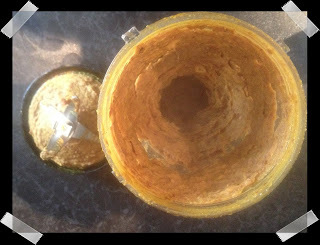 ONE
ONEPre-heat the oven to 180° and dice the red onion.
TWO
Heat a teaspoonful of coconut oil in a large frying pan. Once it melts, throw in the diced red onion.
THREE
Drain a tin of kidney beans and pour the beans in.
FOUR
Add the cumin and turmeric and stir it through to ensure an even coating over the beans and onions. Fry for 5-10 minutes.
FIVE
Allow the pan to cool before carefully spooning its contents into your blender. Briefly blend them (I find 10-15 seconds is sufficient as we aren’t trying to make a smoothie here, just save ourselves a lot of time bean-bashing with a spoon).
SIX
Rub a little coconut oil on a baking tray and spread out two large, wholegrain tortillas. Spoon half of the mixture onto one, and half onto the other.
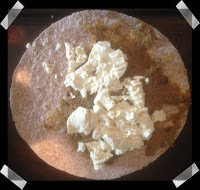 SEVEN
SEVENDrain the silken tofu and then spoon half onto one tortilla and the rest onto the other. If you want something green inside, add a little spinach or coriander (not accounted for in the nutritional information / costings provided).
EIGHT
Fold the tortillas in half and oven bake for 15-20 minutes, until they are lightly browned and crunchy.
NINE
Serve with spinach and generous lashings of light soy sauce (not accounted for in the nutritional information / costings provided).
Published on August 02, 2015 06:06
The Anti-Inflammatory Cookbook | Satay Soya
 Once you do away with meat from grain-fed beasties (so once you do away with meat, then) and remove tomatoes and peppers from the equation, the day’s main meal suddenly becomes much trickier to plan. Fortunately, there’s a wealth of cuisine out there that isn’t built upon inflammatory ingredients – you just need to know where to look, and how to adapt it. Let’s start by looking to the East…
Once you do away with meat from grain-fed beasties (so once you do away with meat, then) and remove tomatoes and peppers from the equation, the day’s main meal suddenly becomes much trickier to plan. Fortunately, there’s a wealth of cuisine out there that isn’t built upon inflammatory ingredients – you just need to know where to look, and how to adapt it. Let’s start by looking to the East…One of my favourite Asian dishes used to be satay chicken, or, better still, satay chicken skewers, which I could eat a near infinite amount of on a Friday night. These dishes’ signature peanut sauce is easily mouldable into an anti-inflammatory form, particularly when fortified with generous amounts of garlic [the ultimate blood sugar regulator and booster of heart health and immunity] and ginger [according to Men’s Health, ginger’s inflammation-fighting properties are double-blind proven], which also give the meal its flavour in the absence of nightshades.
When married up with natural soya protein and a load of crunchy vegetables, this “satay soya” manages to satiate even my illimitable Friday-night takeaway appetite. Of course, being homemade, it does so without leaving as much of a fatty footprint: the dish’s fats are healthy ones, it’s reasonably low in carbohydrates (unless you were to serve it with wholegrain rice or noodles, which you’ll need to add if you’re doing a bulk-up) and, like all my main dishes, it’s high in protein.

150g (dehydrated) natural soya protein [£1.89 per 375g dehydrated, so 76p]
100g crunchy peanut butter [89p for 340g, so 26p]
 50g ginger [59p per 125g, so 24p]
50g ginger [59p per 125g, so 24p]100g carrots [27p per 500g, so 5p]
250ml skimmed milk [89p per 2.72l, so 8p]
75ml dark soy sauce [47p per 150ml, so 24p]
370g beansprouts [49p]
100g mange tout [79p per 150g, so 53p]
4 garlic cloves [around 8p]
1tbsp (15g) unrefined cane sugar [£1.38 for 500g of Billington’s, so 4p]
TOTAL COST TO MAKE TWO PORTIONS: £0.76 + £0.26 + £0.24 +
£0.05 + £0.08 + £0.24 + £0.49 + £0.53 + £0.08 + £0.04 = £2.77
TOTAL COST PER PORTION: £1.39


 ONE
ONE Weigh out 150g of dehydrated soya protein and place it in a small pan.
Holland & Barrett sell natural soya protein either as chunks or minced; nutritionally the stuff is identical, but there’s obviously a difference in texture. I prefer chunks in this dish to emulate the feel of chicken, but it’s just as tasty with mince. I wouldn’t recommend using mycoprotein (such as Quorn) or even soya-based supermarket meat substitutes as they are all heavily processed and likely to contain inflammatory ingredients.
TWO
Fill the pan with cold water and place it on the hob on the lowest heat.
 THREE
THREE Take out a larger pan and heat a little coconut oil in it. Once the oil has melted, throw in the beansprouts and mange tout. Shred 50g of the carrots and throw those in too. Cook until the vegetables are crunchy and brown.
Red onions and kidney beans also go particularly well with this dish, but these aren’t accounted for in the nutritional information / costings provided. If you are planning to use them, throw them into the pan at this stage.
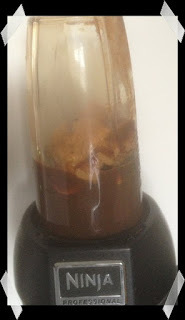 FOUR
FOUR
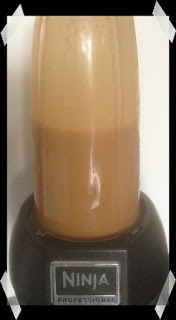
Take the hydrated soya protein off the heat and drain the water. If you are using minced soya protein, take care to use a sieve rather than a colander. Note that the soya has almost doubled in mass.
FIVE
Add the soya protein to the large pan with the vegetables.
SIX
Whilst keeping an eye on the vegetables and soya protein, place the remaining ingredients (50g ginger, 50g carrots, 250ml skimmed milk, 75ml dark soy sauce, 4 garlic cloves, 100g crunchy peanut butter, 1tbsp unrefined cane sugar) in a blender and mix them until you are left with a sauce of suitable thickness for you.
 Those who prefer a thicker sauce needn’t add as much milk or soy sauce at this stage. Those who eat only whole foods, or would enjoy a more authentic Asian sauce, should use 10og oven-roasted peanuts with a little rock salt and coconut oil instead of ready-to-go peanut butter.
Those who prefer a thicker sauce needn’t add as much milk or soy sauce at this stage. Those who eat only whole foods, or would enjoy a more authentic Asian sauce, should use 10og oven-roasted peanuts with a little rock salt and coconut oil instead of ready-to-go peanut butter. If you are feeling really adventurous or health-conscious, you could even use oven-roasted almonds in the place of peanuts. Though peanuts taste better to me, particularly in this dish, almonds have a more favourable protein to fat ratio.
SEVEN
Once the vegetables are crunchy and the soya is lightly browned, stir through the sauce until everything is well-coated.
EIGHT
Cook on a medium heat for 5-10 minutes before serving up.
Published on August 02, 2015 04:34
August 1, 2015
LEGO Castle Review | 6054 Forestmen’s Hideout (also known as “Robin Hood’s Tree Hideaway”)

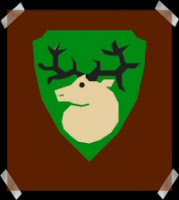 First off, an errata: In my review of the Forestmen’s Camouflaged Outpost set, I said that LEGO “…never officially acknowledged that these forest folk were intended to be Robin Hood and his band of outlaws.” My mother has since proven me wrong, gleefully unearthing an old toy catalogue (that woman hordes everything) that clearly refers to the philanthropic “forest person” as Robin Hood, restoring a little of my faith in both my childhood memories and LEGO’s marketing division.
First off, an errata: In my review of the Forestmen’s Camouflaged Outpost set, I said that LEGO “…never officially acknowledged that these forest folk were intended to be Robin Hood and his band of outlaws.” My mother has since proven me wrong, gleefully unearthing an old toy catalogue (that woman hordes everything) that clearly refers to the philanthropic “forest person” as Robin Hood, restoring a little of my faith in both my childhood memories and LEGO’s marketing division.
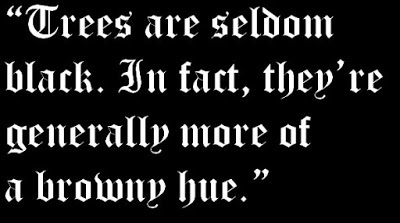 My first Robin Hood LEGO (and that’s what I’m calling it now, as per the image above, which you can click to enlarge) set, was Robin Hood’s Tree Hideaway - a straightforward but nonetheless enchanting set clearly inspired by Sherwood Forest’s Major Oak. The titular tree opens out on hinges to allow little fingers access to the chunky trunk’s interior, where Robin’s ill-gotten gains can be stashed prior to their redistribution. In this set, these ill-gotten gains are represented by a single barrel filled with circular yellow pieces (what passed for coins pre-Pirates), which is quite an improvement on the empty chest found inside the Camouflaged Outpost. Though this was my first Robin Hood set, it was released second, in or around 1988, and so we can assume that the outlaws have honed their rich-robbing skills since their early Camouflaged Outpost days.
My first Robin Hood LEGO (and that’s what I’m calling it now, as per the image above, which you can click to enlarge) set, was Robin Hood’s Tree Hideaway - a straightforward but nonetheless enchanting set clearly inspired by Sherwood Forest’s Major Oak. The titular tree opens out on hinges to allow little fingers access to the chunky trunk’s interior, where Robin’s ill-gotten gains can be stashed prior to their redistribution. In this set, these ill-gotten gains are represented by a single barrel filled with circular yellow pieces (what passed for coins pre-Pirates), which is quite an improvement on the empty chest found inside the Camouflaged Outpost. Though this was my first Robin Hood set, it was released second, in or around 1988, and so we can assume that the outlaws have honed their rich-robbing skills since their early Camouflaged Outpost days.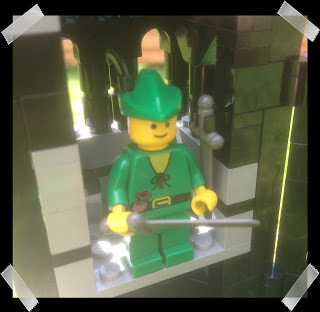 Upstairs, meanwhile, is a rustic little treehouse furnished with medieval weaponry. It feels a little deeper set and organic than the aberrantly fortified Camouflaged Outpost, but it’s still marred a little on the exterior by an outstanding (in the negative sense of the word) blue roof, not to mention the two Forestmen shields hanging from the balcony and the crowning big red flag which announce the hideout’s location to the Crusaders.
Upstairs, meanwhile, is a rustic little treehouse furnished with medieval weaponry. It feels a little deeper set and organic than the aberrantly fortified Camouflaged Outpost, but it’s still marred a little on the exterior by an outstanding (in the negative sense of the word) blue roof, not to mention the two Forestmen shields hanging from the balcony and the crowning big red flag which announce the hideout’s location to the Crusaders.The set boasts some nice finishing touches. Two vines – quite rare pieces, for the late ’80s - hang down from the treehouse, allowing the outlaws access to it (there’s no stairs, see), while the base plates are decorated with a couple of traditional LEGO trees and an impressive little archery target - another rare piece, making its first appearance here. There’s certainly plenty here on offer for the set’s modest RRP, and having recently rebuilt the set again with my nearly four-year-old daughter, I can see why I loved it so much when I was a sprog. I just hope that it serves Andrea, Olivia and Stephanie et alii as well as it did Robin and Will.
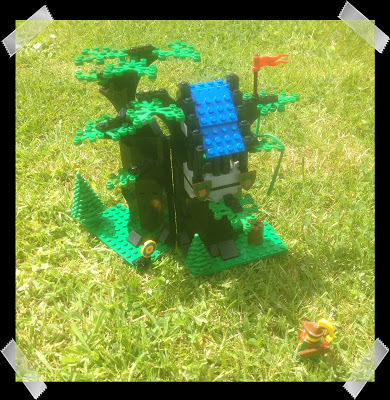 The two-hundred piece set could be improved upon substantially, however, were Robin Hood and his followers ever fortunate enough to be revisited by LEGO. The most pressing issue to be addressed here is, clearly, the colour of the tree. Trees are seldom black. In fact, they’re generally more of a browny hue. From what I recall, besides the odd horse or accessory, it was extraordinary to see brown LEGO pieces in play in the ’80s, but today there is no reason at all why the tree couldn’t be rendered more realistically – just look at the stunning Ewok Village recently put out under the Star Wars banner. Similarly, the foliage could be improved upon with a little bit of finesse; a couple of shades of green and more variance in the piece sizes would look a lot better, for instance, particularly if they were arranged in a more dense formation towards the treetop. And, needless to say, bin the flag.
The two-hundred piece set could be improved upon substantially, however, were Robin Hood and his followers ever fortunate enough to be revisited by LEGO. The most pressing issue to be addressed here is, clearly, the colour of the tree. Trees are seldom black. In fact, they’re generally more of a browny hue. From what I recall, besides the odd horse or accessory, it was extraordinary to see brown LEGO pieces in play in the ’80s, but today there is no reason at all why the tree couldn’t be rendered more realistically – just look at the stunning Ewok Village recently put out under the Star Wars banner. Similarly, the foliage could be improved upon with a little bit of finesse; a couple of shades of green and more variance in the piece sizes would look a lot better, for instance, particularly if they were arranged in a more dense formation towards the treetop. And, needless to say, bin the flag. As for the minifigures, a little more detail in the faces and outfits would quickly bring them up to spec, and a change of mood certainly wouldn’t go amiss. There’s something terribly unsettling about a smiling outlaw brandishing a sword.
Published on August 01, 2015 01:35
July 28, 2015
Star Wars LEGO Review | 75053 The Ghost

Before Han Solo dragged his Millennium Falcon into the fight against the Galactic Empire, another weathered old freighter had already made a name for itself, and this is it: The Ghost, in brick form.
 For a ship so packed with pods and bays and secret compartments, this 33cm beast is as solid as they come; it’s an almost indestructible oblong that you can really believe incited rebellion in the Outer Rim. Inevitably the interior has been scaled down - right down - to meet LEGO’s size / piece requirements for a light-heavyweight set, so there are no crew quarters for one thing, but it’s hard to grumble when every millimetre of available space has been used so creatively. There’s a space on board for every rebel minifigure included, with Hera Syndulla and Kanan Jarrus each having a cockpit apiece and Zeb Orrelios slotting inside the rotatable gun turret so that he can blast the hell out of any passing TIE fighters. Even Ezra and Chopper, who aren’t included in this set, aren’t left out in the cold as their sold-separately Phantom docks neatly in the aft section (a great gimmick in of itself).
For a ship so packed with pods and bays and secret compartments, this 33cm beast is as solid as they come; it’s an almost indestructible oblong that you can really believe incited rebellion in the Outer Rim. Inevitably the interior has been scaled down - right down - to meet LEGO’s size / piece requirements for a light-heavyweight set, so there are no crew quarters for one thing, but it’s hard to grumble when every millimetre of available space has been used so creatively. There’s a space on board for every rebel minifigure included, with Hera Syndulla and Kanan Jarrus each having a cockpit apiece and Zeb Orrelios slotting inside the rotatable gun turret so that he can blast the hell out of any passing TIE fighters. Even Ezra and Chopper, who aren’t included in this set, aren’t left out in the cold as their sold-separately Phantom docks neatly in the aft section (a great gimmick in of itself).
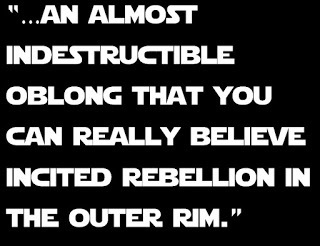 The set also boasts features to please those of all tastes. For youngsters, there are two spring-loaded missile canons which lend themselves beautifully to interstellar LEGO dogfights, as well as two detachable escape pods that each have room for at least one minifigure. For adult fans, meanwhile, there are deft little touches to be appreciated such as the hidden Holocron and working cargo hatch, not to mention two long (but shallow) cargo holds in which the set’s many weapons can be safely stowed while the minifigures are at their stations.
The set also boasts features to please those of all tastes. For youngsters, there are two spring-loaded missile canons which lend themselves beautifully to interstellar LEGO dogfights, as well as two detachable escape pods that each have room for at least one minifigure. For adult fans, meanwhile, there are deft little touches to be appreciated such as the hidden Holocron and working cargo hatch, not to mention two long (but shallow) cargo holds in which the set’s many weapons can be safely stowed while the minifigures are at their stations.
As to the minifigures, the three rebels are dazzling. Zeb is one of my favourite Star Wars minifigures to date. Whilst necessarily lacking the towering height of his on-screen alter ego, his headpiece especially is incredibly detailed, goatee and all, and the modellers have even captured his near-constant look of thinly-veiled irritation wonderfully. The sole human figure is less striking, obviously, but nonetheless a great likeness of the former Jedi, while the Twi’lek minifigure has caught Hera’s exotic and worldly qualities in equal measure: green skin, prehensile tentacles… flying goggles. Instead of Sabine Wren, though, the set is rounded out with a redundant standard-issue Disney stormtrooper, which LEGO have added blue rendering to in order to set it apart from its movie-era counterparts. It’s disappointing not to be able to net the full Ghost crew for the cost of two sets - LEGO obviously want us to buy the stand-alone Sabine sets too.

Overall though, The Ghost and its sister set come highly recommended. You can pick up both for the price of a decent heavyweight set, and you’ll probably get a lot more fun for your money. The Ghost is available to buy from LEGO directly for £69.99 with free delivery. However, today’s cheapest retailer is Amazon, who are selling the set for just £62.65 with free delivery.
Published on July 28, 2015 14:00
Star Wars LEGO Review | 75048 The Phantom
 As a kid, I was regularly treated to “Battle Pack”-sized LEGO sets, but gifts from the next tier up were fewer and farther between, and all the more special for it. I have very fond memories of building police trucks and ambulances with all sorts of playable features; the relatively modest increase in price didn’t seem equal to the profound improvement in playability. Now, as an adult, it’s pleasing to see that LEGO are continuing to make sets in their £20-ish range just as crammed with value, and Star Wars Rebels set The Phantom is a case in point.
As a kid, I was regularly treated to “Battle Pack”-sized LEGO sets, but gifts from the next tier up were fewer and farther between, and all the more special for it. I have very fond memories of building police trucks and ambulances with all sorts of playable features; the relatively modest increase in price didn’t seem equal to the profound improvement in playability. Now, as an adult, it’s pleasing to see that LEGO are continuing to make sets in their £20-ish range just as crammed with value, and Star Wars Rebels set The Phantom is a case in point.
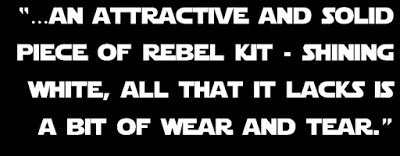 Larger than its box would suggest, Ezra Bridger’s separable spaceship has much more to it than meets the eye. Its spring-loaded missiles can fire to both aft and stern, its cockpit section is more spacious than you’d expect, and its aft section has double-hinged wings that unfurl for flight or fold up neatly for docking in
The Ghost
. I didn’t expect there to be any sort of interior in the aft compartment, but the roof lifts off to reveal a perfectly Chopper-sized space, and the rear door hides a space just large enough to stow Ezra’s Imperial helmet and blaster. It’s an attractive and solid piece of rebel kit - shining white, all that it lacks is a bit of wear and tear.
Larger than its box would suggest, Ezra Bridger’s separable spaceship has much more to it than meets the eye. Its spring-loaded missiles can fire to both aft and stern, its cockpit section is more spacious than you’d expect, and its aft section has double-hinged wings that unfurl for flight or fold up neatly for docking in
The Ghost
. I didn’t expect there to be any sort of interior in the aft compartment, but the roof lifts off to reveal a perfectly Chopper-sized space, and the rear door hides a space just large enough to stow Ezra’s Imperial helmet and blaster. It’s an attractive and solid piece of rebel kit - shining white, all that it lacks is a bit of wear and tear.
The two minifigures are both excellent too. LEGO have, by now, perfected the astromech droid, and so Chopper is vested with both the look and feel of his cartoon counterpart. Pleasingly his build differs from other astromechs that I’ve built, which I think is quite fitting for the contrary little fellow. Ezra, whilst lacking his lightsaber cum blaster (which I don’t think he’d built at the time of this set’s release, in fairness), is a dead ringer for TV’s wayward orphan. I did initially question the use of “adult” legs for him, but on reflection I think they’ve made the right call - he’s closer to the surly teenage Anakin of Attack of the Clones than he is the exasperating infant of The Phantom Menace.
The Phantom is available to buy from LEGO directly for £19.99 with free delivery on orders over £50.00. However, today’s cheapest retailer is Amazon, who are selling the set for just £14.59 with free delivery on orders over £20.00.
Published on July 28, 2015 13:02
July 26, 2015
Blu-ray Review | Robin of Sherwood: Michael Praed Limited Edition Box Set
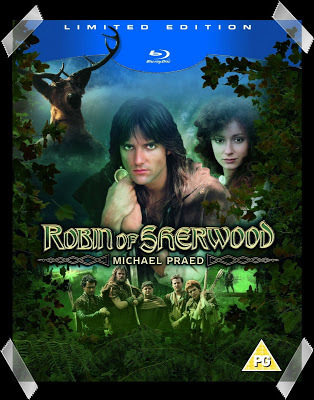 To this day, Richard ‘Kip’ Carpenter’s radical reworking of the Robin Hood legend is still widely regarded as being the definitive interpretation. Carpenter’s irresistible fusion of swords and sorcery with raw grit and brutality sets it apart not only from any other iteration of the popular myth, but anything else on television then or since.
To this day, Richard ‘Kip’ Carpenter’s radical reworking of the Robin Hood legend is still widely regarded as being the definitive interpretation. Carpenter’s irresistible fusion of swords and sorcery with raw grit and brutality sets it apart not only from any other iteration of the popular myth, but anything else on television then or since. Network’s limited edition Michael Praed Blu-ray box set is a pleasantly lush and splendorous thing, housing all thirteen almost hour-long episodes featuring Praed as the eponymous wolfshead, rendered in 1080p from the original film elements (TNG-style!), as well as all of the special features that were featured on the first two series’ DVD releases in 2002 and a remastered 1983 documentary to boot. Amongst them are the series’ notorious blooper reels; the enlightening two-part Nothing’s Forgotten documentary; and a series of HD shorts featuring second-season director Robert Young discussing his most noteworthy episodes. The set is beautifully presented, with the blue-tipped slipcase sliding off to reveal a verdantly-clad amaray case. Inside you’ll find a hefty and insightful companion booklet duly entitled Legend, together with full synopses and airdates for each episode on the underside of the cover along with details of their accompanying special features. My only minor niggle is that, even with the discs taken out, this information is still difficult to read; otherwise, the presentation is perfect. With disc-based media becoming more outmoded by the day, this set serves as a pleasant reminder of its appeal, as well as a shining example to other media distributors who’ve long-since abandoned collectors’ booklets and the like in their physical releases.
 “You were sleeping; you slept too long. We all have.It’s time we woke. Time we stopped running.”
“You were sleeping; you slept too long. We all have.It’s time we woke. Time we stopped running.” 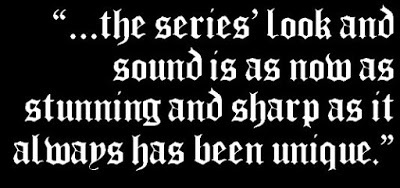 The episodes themselves are a monumental improvement on their DVD counterparts. Grainy and filmic, yet abounding with deep colour and rich sound, these thirteen mini-movies (fifty-four minutes apiece) hold up exceedingly well today – you can see every penny of the £300,000.00 that went into each on screen. They have a timeless quality to them that’s buoyed by the aberrantly high production standards for the era; there’s scarcely a scene here that feels studio-bound, and with HD locations as stunning and diverse as the coastal Anwick and Bamborough castles (the latter being particularly breathtaking) and the incidental music of the BAFTA-award winning Clannad underscoring many a memorable moment, the series’ look and sound is as now as stunning and sharp as it always has been unique.
The episodes themselves are a monumental improvement on their DVD counterparts. Grainy and filmic, yet abounding with deep colour and rich sound, these thirteen mini-movies (fifty-four minutes apiece) hold up exceedingly well today – you can see every penny of the £300,000.00 that went into each on screen. They have a timeless quality to them that’s buoyed by the aberrantly high production standards for the era; there’s scarcely a scene here that feels studio-bound, and with HD locations as stunning and diverse as the coastal Anwick and Bamborough castles (the latter being particularly breathtaking) and the incidental music of the BAFTA-award winning Clannad underscoring many a memorable moment, the series’ look and sound is as now as stunning and sharp as it always has been unique.Some might lament the order of the episodes’ presentation across the discs, which is not how they were transmitted, but in continuity order. To me, it makes perfect sense that “The Swords of Wayland” should precede “The Prophecy”, for instance, as Marion still believes her father to be dead in the former; however, some are still sticklers for broadcast presentation. What does annoy me though is that each season’s feature-length offering has been cleaved in two, again differing from transmission, but this time for the worse.

With the possible exception of Robert Addie’s still-brilliant Gisburne, whom Richard Armitage would give a run for his money in the BBC’s 2006 version, the classic Robin Hood characters have never been bettered in any iteration of the myth. Michael Praed has incredible gravitas as Robin - his rugged good looks and quicksilver voice define the role, but Praed tempers the part with a calm and often surprisingly gentle edge that both Judi Trott’s Marion and Peter Llewellyn Williams’ Much bring to the fore. What I like most about this portrayal though is it’s pragmatism. I realise that this sounds absurd when I’m taking about an interpretation of the character who’s hand-picked by a shaman to be his spiritual son and cloaked in as much mysticism as he is woodland greenery, but it’s true nonetheless. Does he wear a shitty little hat with a feather in it? Of course not. He wears a hood that obscures his outlaw features and earns him the makes-total-sense nommes de guerre, “Robin in the Hood” and “The Hooded Man”. Does he balk at killing Norman soldiers? Nope. He’s a terrorist who shoots them down from a distance or slices them up by sword at close quarters. Do his magical powers see him win every week, and without cost? No. Two of his men die in the first story alone, and more would follow. And, in the end, he loses – look at a history book, he has to. But Robin of Sherwood, and indeed the larger Robin Hood myth, isn’t about toppling a regime - it’s about the nobility in resistance; the necessity of a social conscience. As Robin himself says, the war between good and evil, or “the powers of light and darkness”, if you will, never ends.

The standouts amongst his Not-So-Merry Men are easily Clive Mantle’s John of Hathersage and Ray Winstone’s “psychopathic football hooligan”, Will Scathlock (Scarlet). The former is fairly faithful to the traditional gentle-giant paradigm, but his youth exacerbates his vulnerability to the extent that he blubbers almost as often as he cracks Norman heads. This makes him all the more real, and all the more endearing.
 “I killed three of the bastards. I’m gonna swing.”
“I killed three of the bastards. I’m gonna swing.” The latter goes the other way - Winstone’s character is a bitter, vengeful hardman who went on a Norman killing spree following the rape and murder of his wife at the hands of mercenaries. When Robin springs him from jail, he joins his band of rebels, but throughout the series there’s a nagging doubt that his motivation isn’t quite as unselfish as his peers. The look on his face as he kills is as frightening as anything you’ll see on the other side of the divide, and it’s exactly this sort of credible greyscale that makes this series so damned compelling.
 “Ah but which devil? There are so many, aren’t there?And only one God. Hardly seems fair.”
“Ah but which devil? There are so many, aren’t there?And only one God. Hardly seems fair.” And on the other side of the fence, the quality is every bit as high. Lord High Sheriff of Nottingham Robert de Rainault is as wicked and immoral as ever a sheriff were, yet Nickolas Grace imbues him with a dry sense of humour that almost makes him likeable. Every episode he graces is teeming with witty asides and one-liners - many at Gisburne’s expense (“The halfwit, my lord! The halfwit!” / “Which one?”), many not (“Why are you men of God so damned acquisitive?”) - together with vitriolic tantrums that are almost pitiable. Nobody’s ever pitched the part better and I doubt that anyone ever will.
 “By Christ, Robert, I will not lose my fish pond!”
“By Christ, Robert, I will not lose my fish pond!” And to Carpenter’s credit, he gives de Rainault more than one foil. The Abbot Hugo de Rainault, brother to the sheriff, often lends the proceedings a little much-needed levity, but more importantly, he embodies the corrupt establishment that Robin and his band are rebelling against. This is never demonstrated more beautifully than in the first series’ opener, “Robin Hood and the Sorcerer”, in which he plots to make a nun of his young ward, the Lady Marion of Leaford, just so that he can usurp her late father’s lands.
 “He’s coming. The Hooded Man is coming...”
“He’s coming. The Hooded Man is coming...”“Robin Hood and the Sorcerer” is in fact the set’s unequivocal highlight. Its storybook title is the only thing about it that I could criticise; everything else about it is ingeniously conceived and mercurially executed. The pre-title sequence is one of the best that I’ve seen in any show, and is particularly effective as it sets the stall for what’s to come in its even-handed juxtaposition of mysticism and slaughter. The sight of those Norman soldiers silently drifting across the waters towards Loxley, their menace growing ever louder through Clannad’s tentative rumblings, is more haunting in many ways than the immolation that they unleash upon young Robin’s native village.

The ensuing tale does a sterling job of weaving aspects of the myth with Carpenter’s mystical elements. The disguised Robin still famously splits an arrow to win the sheriff’s archery tournament, for instance, but he does so only to reclaim his inheritance: the Silver Arrow, a pagan symbol vested with great power and belonging to Herne the Hunter, a shaman who serves as Robin’s mentor. The recently-outlawed Robin still fights John when they first meet, and indeed gives him his “Little” soubriquet, but here they fight because John is possessed by the Baron de Belleme, who, to the surprise of many, is this first story’s principal antagonist rather than the sheriff. Belleme (played by the awesome Anthony Valentine) has his sights set on Abbot Hugo’s young ward, and with his “Hooded Man” prophecies being borne out, much to the sheriff’s dismay, he now has the necessary leverage to get her. At heart, for all its enthralling setups and set pieces, “Robin Hood and the Sorcerer” is the classic tale of Robin setting out to rescue his lover from the clutches of an evil-doer. What sets it apart are its demons, which exist literally in the case of the baron, and metaphorically for just about everyone else.
 “They are all waiting: the blinded, the maimed,
“They are all waiting: the blinded, the maimed,the men locked in the stinking dark.
They all wait for you...”
Even Shamanic cave-dweller Herne the Hunter, the personification of the powers of light in the series, is shrouded in literal darkness. I remember having nightmares as a child about his half-lit, horned silhouette and John Abineri’s gravelly proclamations: “When the Horned One possesses me, I am Herne the Hunter.” Yet there’s a naturalistic innocence about the character; a straightforwardness that still confounds me to this day. Robin calls him a man, and Herne doesn’t deny it – rather, he removes his costume and greets him as a man. Yet he’s clearly imbued with the spirit of the lord of the trees; demonstrably vested with the sort of knowledge and foresight that one would normally only associate with somebody in league with the Devil.

“Robin Hood and the Sorcerer” is also notable for its introduction of Mark Ryan’s Nasir, the baron’s hand-picked archer and ambidextrous swordsman. As he possessed such a commanding presence on screen, rather than kill him off in the story’s dénouement, the producers restructured the story’s climactic fight scene to hint at a budding respect between the wolfshead and the Saracen, with Nasir then showing up in Sherwood right at the death with a wry smile on his face. His joining the band is never discussed or even acknowledged; he’s simply there from that point forward, mysterious and brooding, silent but deadly, quietly and effortlessly embodying the tone of the series. It’s a testament to both the character and Ryan’s performance that many subsequent interpretations have included a Saracen within the ensemble.

“The Witch of Elsdon” is the first episode to see the outlaws start to earn their philanthropic reputation, robbing the rich to help the people of Nottingham. It also explores what it’s like for a young woman living in a forest with a group of young men - an issue deftly swerved by most interpretations. Judi Trott’s character’s strength is matched only by her gentility, which doesn’t sit well with a group of young men sleeping rough and living between ambushes.

The next episode, “Seven Poor Knights from Acre”, is a real belter, and probably the first season’s best stand-alone episode as it pits the outlaws against a more competent foe in the shape of the Knights Templar. Besides its awesome action sequences, the episode boasts some tremendously entertaining scenes between de Rainault and Gisburne, who can’t believe their luck when the knights decide to hunt down the outlaws who they believe stole their sacred emblem. “Alan a Dale”, by contrast, is a comedy wearing a swashbuckling cloak. Almost every scene is either satirical or slapstick, and Nickolas Grace is at the height of his powers as his misogynistic sheriff reluctantly prepares to wed the forlorn minstrel’s young lover in order to get her lands.

The season finale, “The King’s Fool”, is a clever and ultimately quite touching piece that cements the outlaws’ brotherhood. I particularly like John Rhys-Davies’ (The Lord of the Rings) portrayal of Lionheart, who’s depicted as a reckless, impulsive tyrant no better than his historically-reviled little brother. All that sets them apart are King Richard’s weight and charm, which in this story bewitch Robin far more effectively than any enchantment, hence the title.
 “Those who seek to shatter the bolts that hold back theEvil One must first take Albion from you.”
“Those who seek to shatter the bolts that hold back theEvil One must first take Albion from you.”Up next in the set is the two-part “Swords of Wayland”, a devilish and genuinely chilling tale based upon a myth that Kip Carpenter gleefully admits having invented. The story takes the outlaws far from Sherwood - all the way to Robin Hood’s Bay, in fact (“Ahh...”) - where Robin’s mystical sword, Albion, becomes a pawn in a plot to raise Satan. The directorial debut of Robert Young, who would take over from Ian Sharp at the helm, it’s the most beautifully shot episode of the series, abounding with haunting, blood-red skies and sprawling, coastal vistas - and probably its scariest too. Rula Lenska’s Morgwyn of Ravenscar is every bit as terrifying as the fallen angel that she wants to raise.
 With the second season’s opening episode, “The Prophecy”, the series starts to ring in some changes, not least of which is John’s coronation as king following Richard’s death in battle. This introduces Phil Davis (Doctor Who, Sherlock, Ashes to Ashes, Being Human) as a semi-regular villain - and what a villain. With de Rainault absent, King John fills the empty “lunatic tyrant” role with seething and irrational aplomb, and perhaps even makes a better job of making Gisburne’s existence hell. With an even less tolerant paymaster than usual, the pressure sees the “stupid and reactionary Tory minister” pushed well beyond his breaking point. The plot itself contains the return to England of Marion’s father, Richard of Leaford, and is chock full of misdirection and intrigue. It also boasts my favourite Will Scarlet scene; one that’s played so very brutally by Ray Winstone that it’s hard to tell the heroes from the villains.
With the second season’s opening episode, “The Prophecy”, the series starts to ring in some changes, not least of which is John’s coronation as king following Richard’s death in battle. This introduces Phil Davis (Doctor Who, Sherlock, Ashes to Ashes, Being Human) as a semi-regular villain - and what a villain. With de Rainault absent, King John fills the empty “lunatic tyrant” role with seething and irrational aplomb, and perhaps even makes a better job of making Gisburne’s existence hell. With an even less tolerant paymaster than usual, the pressure sees the “stupid and reactionary Tory minister” pushed well beyond his breaking point. The plot itself contains the return to England of Marion’s father, Richard of Leaford, and is chock full of misdirection and intrigue. It also boasts my favourite Will Scarlet scene; one that’s played so very brutally by Ray Winstone that it’s hard to tell the heroes from the villains. “Lord of the Trees” is an unusual tale in which the outlaws must try to prevent Gisburne and a band a French mercenaries pillaging their way through the villages of Nottinghamshire - but without shedding their blood, lest Herne withdraw his blessing and the villages’ crops fail. It’s an interesting conceit, especially given the series’ customary bloodiness and Scarlet’s iller-than-usual feeling towards the mercenaries, but by this point Nickolas Grace is sorely missed (which might explain ITV’s decision to jumble up the episodes for broadcast, eking him out over the season).
“Lord of the Trees” is an unusual tale in which the outlaws must try to prevent Gisburne and a band a French mercenaries pillaging their way through the villages of Nottinghamshire - but without shedding their blood, lest Herne withdraw his blessing and the villages’ crops fail. It’s an interesting conceit, especially given the series’ customary bloodiness and Scarlet’s iller-than-usual feeling towards the mercenaries, but by this point Nickolas Grace is sorely missed (which might explain ITV’s decision to jumble up the episodes for broadcast, eking him out over the season).
Fortunately, Grace’s sheriff returns with all due megalomania in “The Children of Israel”, in which he finds himself pitted against not just the outlaws, but the powerful nation of money-lenders that props up England’s economy too. It’s a delight to see de Rainault spar with an intelligent, articulate and passive foe for a change, and Gisburne’s attempted dalliance with the money-lender’s daughter is every bit as entertaining - albeit for very different reasons. The episode also allows the long-running tension between Robin and Will to boil over, resulting in Will turning his back on his friends - for a while, at least. It’s subplots like these that make the show such an engrossing and believable drama. It beggars belief that two such strong, opposing personalities could get along - so they don’t.

The box set’s penultimate offering, “The Enchantment”, finds Robin in the thrall of a seductive sorceress – one with a connection to a very old and very powerful enemy. For all its big gimmicks and surprises though, it’s a bit of an empty affair, carried almost entirely by the sheriff and Gisburne, whose greed here somehow manages to eclipse that of the preceding episode.

My favourite second-season episode, though, has to be the peerless finale, “The Greatest Enemy”, which is arguably the series’ finest hour. On the face of it, there’s not all that much to it: faced with being ousted from office if he fails to put down Robin once and for all, the sheriff finally puts the full might of his forces into flushing out and killing the wolfshead. The beauty of the piece is that he succeeds with relative ease, only to realise too late that you can kill a man, but there’s no killing a legend.

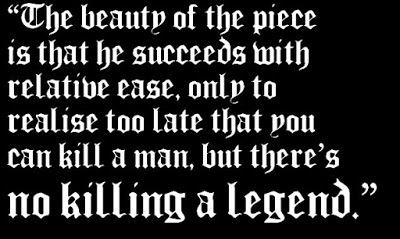 Robin’s demise is handled flawlessly. Throughout the episode Carpenter’s script forces him into an ever-tighter corner, until he finally realises that there’s no way out. Then, the script slows, the circle tightens, and Michael Praed and Judi Trott give the performances of their lives as his Robin must prepare not just to die in a hail of crossbow fire, but also convince his soon-to-be widow to face the much more daunting task of living on without him. You’ll be hard-pressed to find a more heartrending scene anywhere; it’s Robin’s almost unnatural calmness, his resignation, that really sells it. For a “nervous young wolf” he’s remarkably Zen.
Robin’s demise is handled flawlessly. Throughout the episode Carpenter’s script forces him into an ever-tighter corner, until he finally realises that there’s no way out. Then, the script slows, the circle tightens, and Michael Praed and Judi Trott give the performances of their lives as his Robin must prepare not just to die in a hail of crossbow fire, but also convince his soon-to-be widow to face the much more daunting task of living on without him. You’ll be hard-pressed to find a more heartrending scene anywhere; it’s Robin’s almost unnatural calmness, his resignation, that really sells it. For a “nervous young wolf” he’s remarkably Zen. “Tell the sheriff of Nottingham that Robin Hood
“Tell the sheriff of Nottingham that Robin Hoodholds Sherwood. Tell him that Herne’s son
has claimed his kingdom.”
But as one outlaw is facing his end, Herne is already blowing another “leaf on the wind” into position to take on his mantle. Taking full advantage of the legend’s ambiguity, Kip Carpenter would go on to explore the Pyle-sanitised version of the nation’s most famous tale though a new, gentrified lead in the third season: Robert of Huntingdon, son of an earl, portrayed by an astonishingly blonde and clean-cut young man by the name of Jason Connery (Doctor Who: “Vengeance on Varos”).
 “You ungrateful bastard!”
“You ungrateful bastard!” For me, however, Robin of Sherwood’s final series would lack the defining rough edges of the Michael Praed years. So rarely is Robin portrayed as a young, poor peasant turned altruistic freedom fighter; rarer still will you find him in the company of plausibly dangerous outlaws who could credibly throw a county into chaos. By turns haunting and bloody, Robin of Sherwood can hold its viewers rapt, whether they were watching it during its original 1985-1987 run on ITV or are enjoying it in high-definition on Blu-ray today. It can also teach young boys how to swear, much to the chagrin of their parents and teachers, but that’s another story...
The Robin of Sherwood: Michael Praed Limited Edition Box Set is currently cheapest at Amazon, where you can it up for £33.92 with free delivery.
Published on July 26, 2015 08:06
Blu-ray Review | Robin of Sherwood: Michael Praed (Limited Edition) Box Set
 To this day, Richard ‘Kip’ Carpenter’s radical reworking of the Robin Hood legend is still widely regarded as being the definitive interpretation. Carpenter’s irresistible fusion of swords and sorcery with raw grit and brutality sets it apart not only from any other iteration of the popular myth, but anything else on television then or since.
To this day, Richard ‘Kip’ Carpenter’s radical reworking of the Robin Hood legend is still widely regarded as being the definitive interpretation. Carpenter’s irresistible fusion of swords and sorcery with raw grit and brutality sets it apart not only from any other iteration of the popular myth, but anything else on television then or since. The limited edition Michael Praed Blu-ray box set is a pleasantly lush and splendorous thing, housing not only all thirteen almost hour-long episodes featuring Praed as the eponymous wolfshead, rendered in 1080p from the original film elements (TNG-style!), but also all of the special features that were featured on the first two series’ DVD releases in 2002 and a remastered 1983 documentary to boot. The set is beautifully presented, with the blue-tipped slipcase sliding off to reveal a verdantly-clad amaray case. Inside you’ll find a hefty and insightful companion booklet duly entitled Legend, together with full synopses and airdates for each episode on the underside of the cover along with details of their accompanying special features. My only minor niggle is that, even with the discs taken out, this information is still difficult to read; otherwise, the presentation is perfect. With disc-based media becoming more outmoded by the day, this set serves as a pleasant reminder of its appeal, as well as a shining example to other media distributors who’ve long-since abandoned collectors’ booklets and the like in their physical releases.
“You were sleeping; you slept too long. We all have.It’s time we woke. Time we stopped running.”
The episodes themselves are a monumental improvement on their DVD counterparts. Grainy and filmic, yet abounding with deep colour and rich sound, these thirteen mini-movies (fifty-four minutes apiece) hold up exceedingly well today – you can see every penny of the £300,000.00 that went into each. They have a timeless quality to them that’s buoyed by the aberrantly high production standards for the era; there’s scarcely a scene here that feels studio-bound, and with HD locations as stunning as diverse as the coastal Anwick and Bamborough castles (the latter being particularly breathtaking) and the incidental music of the BAFTA-award winning Clannad underscoring many a memorable moment, the series’ look and sound is as now as stunning and sharp as it always has been unique.
Some might lament the order of the episodes’ presentation across the discs, which is not how they were transmitted, but in continuity order. To me, it makes perfect sense that “The Swords of Wayland” should precede “The Prophecy”, for instance, as Marion still believes her father to be dead in the former; however, some are still sticklers for broadcast presentation. What does annoy me though is that each season’s feature-length offering has been cleaved in two, again differing from transmission, but this time for the worse.
“Albion, one of the seven swords of Wayland, charged with the power of light and darkness.”
With the possible exception of Robert Addie’s still-brilliant Gisburne, whom Richard Armitage would give a run for his money in the BBC’s 2006 version, the classic Robin Hood characters have never been bettered in any iteration of the myth. Michael Praed has incredible gravitas as Robin - his rugged good looks and quicksilver voice define the role, but Praed tempers the part with a calm and often surprisingly gentle edge that both Judi Trott’s Marion and Peter Llewellyn Williams’ Much bring to the fore. What I like most about this portrayal though is it’s pragmatism. I realise that this sounds absurd when I’m taking about an interpretation of the character who’s hand-picked by a shaman to be his spiritual son and cloaked in as much mysticism as he is woodland greenery, but it’s true nonetheless. Does he wear a shitty little hat with a feather in it? Of course not. He wears a hood that obscures his outlaw features and earns him the makes-total-sense nommes de guerre, “Robin in the Hood” and “The Hooded Man”. Does he balk at killing Norman soldiers? Nope. He’s a terrorist who shoots them down from a distance or slices them up by sword at close quarters. Do his magical powers see him win every week, and without cost? No. Two of his men die in the first story alone, and more would follow. And, in the end, he loses – look at a history book, he has to. But Robin of Sherwood, and indeed the larger Robin Hood myth, isn’t about toppling a regime - it’s about the nobility in resistance; in helping others. As Robin himself says, the war between good and evil, or “the powers of light and darkness”, if you will, never ends.
The standouts amongst his Not-So-Merry Men are easily Clive Mantle’s John of Hathersage and Ray Winstone’s “psychopathic football hooligan” Will Scathlock / Scarlet. The former is fairly faithful to the traditional gentle-giant paradigm, but his youth exacerbates his vulnerability to the extent that he blubbers almost as often as he cracks Norman heads. This makes him all the more real, and all the more endearing.
“I killed three of the bastards. I’m gonna swing.”
The latter goes the other way - Winstone’s character is a bitter, vengeful hardman who went on a Norman killing spree following the rape and murder of his wife at the hands of mercenaries. When Robin springs him from jail, he joins his band of rebels, but throughout the series there’s a nagging doubt that he’s motivation isn’t quite as unselfish as his peers. The look on his face as he kills is as frightening as anything you’ll see on the other side of the divide, and it’s exactly this sort of credible greyscale that makes this series so damned compelling.
“Ah but which devil? There are so many, aren’t there?And only one God. Hardly seems fair.”
And on the other side of the fence, the quality is every bit as high. Lord High Sheriff of Nottingham Robert de Rainault is as wicked and immoral as ever a sheriff were, yet Nickolas Grace imbues him with a dry sense of humour that almost makes him likeable. Every episode he graces is teeming with witty asides and one-liners - many at Gisburne’s expense (“The halfwit, my lord! The halfwit!” / “Which one?”), many not (“Why are you men of God so damned acquisitive?”) - together with vitriolic tantrums that are almost pitiable. Nobody’s ever pitched the part better and I doubt that anyone ever will.
“By Christ, Robert, I will not lose my fish pond!”
And to Carpenter’s credit, he gives de Rainault more than one foil. The Abbot Hugo de Rainault, brother to the sheriff, often lends the proceedings a little much-needed levity, but more importantly, he embodies the corrupt establishment that Robin and his band are rebelling against. This is never demonstrated more beautifully than in the first series’ opener, “Robin Hood and the Sorcerer”, in which he plots to make a nun of his young ward, the Lady Marion of Leaford, just so that he can usurp her father’s lands.
“He’s coming. The Hooded Man is coming...”
“Robin Hood and the Sorcerer” is in fact the set’s unequivocal highlight. Its storybook title is the only thing about it that I could criticise; everything else about it is ingeniously conceived and mercurially executed. The pre-title sequence is one of the best that I’ve seen in any show, and is particularly effective as it sets the stall for what’s to come in its even-handed juxtaposition of mysticism and slaughter. The sight of those Norman soldiers silently drifting across the waters towards Loxley, their menace growing ever louder through Clannad’s tentative rumblings, is more haunting in many ways than the immolation that they unleash upon Loxley - young Robin’s native village.
The ensuing tale does a sterling job of weaving aspects of the myth with Carpenter’s mystical elements. The disguised Robin still famously splits an arrow to win the sheriff’s archery tournament, for instance, but he does so only to reclaim his inheritance: the Silver Arrow, a pagan symbol vested with great power and belonging to Herne the Hunter, a shaman who serves as Robin’s mentor. The recently-outlawed Robin still fights John when they first meet, and indeed gives him his “Little” soubriquet, but here they fight because John is possessed by the Baron de Belleme, who, to the surprise of many, is the story’s principal antagonist rather than the sheriff. Belleme has his sights set on the sheriff’s brother’s young ward, and with his “Hooded Man” prophecies being borne out, much to the sheriff’s dismay, he now has the necessary leverage to get her. At heart, for all its enthralling setups and set pieces, “Robin Hood and the Sorcerer” is the classic tale of Robin setting out to rescue his lover from the clutches of an evil-doer. What sets it apart are its demons, which exist literally in the case of the baron, and metaphorically for just about everyone else. “They are all waiting: the blinded, the maimed, the men locked in the stinking dark. They all wait for you...”
Even Shamanic cave-dweller Herne the Hunter, the personification of the powers of light in the series, is shrouded in literal darkness. I remember having nightmares as a child about his half-lit, horned silhouette and John Abineri’s gravelly proclamations: “When the Horned One possesses me, I am Herne the Hunter.” Yet there’s a naturalistic innocence about the character; a straightforwardness that still confounds me to this day. Robin calls him a man, and Herne doesn’t deny it – rather, he removes his costume and greets him as a man. Yet he’s clearly imbued with the spirit of the lord of the trees; demonstrably vested with the sort of knowledge and foresight that one would normally only associate with somebody in league with the Devil.
“Robin Hood and the Sorcerer” is also notable for its introduction of Mark Ryan’s Nazir, the baron’s hand-picked archer and ambidextrous swordsman. As he possessed such a commanding presence on screen, rather than kill him off in the story’s dénouement the producers restructured the story’s climactic fight scene to hint at a budding respect between the wolfshead and the Saracen, with Nazir then showing up in Sherwood right at the death with a wry smile on his face. His joining the band is never discussed or even acknowledged; he’s simply there from that point forward, mysterious and brooding, silent but deadly, quietly and effortlessly embodying the tone of the series. It’s a testament to both the character and Ryan’s performance that many subsequent interpretations have included a Saracen within the ensemble.
“The Witch of Elsdon” is the first episode to see the outlaws start to earn their philanthropic reputation, robbing the rich to help the people of Nottingham. It also explores what it’s like for a young woman living in a forest with a group of young men - an issue deftly swerved by most interpretations. Judi Trott is so convincing as the fiery redhead, but her character’s strength is matched only by her gentility, which doesn’t sit well with a group of young men sleeping rough and living between ambushes.
The next episode, “Seven Poor Knights from Acre”, is a real belter, and probably the first season’s best stand-alone episode as it pits the outlaws against a more competent foe in the shape of the Knights Templar. Besides its awesome action sequences, the episode boasts some tremendously entertaining scenes between de Rainault and Gisburne, who can’t believe their luck when the knights decide to hunt down the outlaws who they believe stole their sacred emblem. “Alan-A-Dale”, by contrast, is a comedy wearing a swashbuckling cloak. Almost every scene is either satirical or slapstick, and Nickolas Grace is at the height of his powers as his misogynistic sheriff reluctantly prepares to wed the forlorn minstrel’s young lover in order to get her lands.
The season finale, “The King’s Fool”, is a clever and ultimately quite touching piece that cements the outlaws’ brotherhood. I particularly like John Rhys-Davies’ (The Lord of the Rings) portrayal of Lionheart, who’s depicted as a reckless, impulsive tyrant no better than his historically-reviled little brother. All that sets them apart are King Richard’s weight and charm, which in this story bewitch Robin far more effectively than any enchantment.
“Those who seek to shatter the bolts that hold back theEvil One must first take Albion from you.”
Up next in the set is the two-part “Swords of Wayland”, a devilish and genuinely chilling tale based upon a myth that Kip Carpenter gleefully admits having invented. The story takes the outlaws far from Sherwood - all the way to Robin Hood’s Bay, in fact (“Ahh...”) - where Robin’s mystical sword becomes a pawn in a plot to raise Satan. The directorial debut of Robert Young, who would take over from Ian Sharp at the helm, it’s the most beautifully shot episode of the series, abounding with haunting, blood-red skies and sprawling, coastal vistas - and probably its scariest too. Rula Lenska’s Morgwyn of Ravenscar is every bit as terrifying as the fallen angel that she wants to raise.
With the second season’s opening episode, “The Prophecy”, the series starts to ring in some changes, not least of which is John’s coronation as king following Richard’s death in battle. This introduces Phil Davis (Doctor Who, Sherlock, Ashes to Ashes, Being Human) as a semi-regular villain - and what a villain. With de Rainault absent for much of the season, he fills the empty “lunatic tyrant” role with seething and irrational aplomb, and perhaps even makes a better job of making Gisburne’s existence hell. With an even less tolerant paymaster than usual, the pressure sees the “stupid and reactionary Tory minister” pushed well beyond his breaking point. The plot itself contains the return to England of Marion’s father, Richard of Leaford, and is chock full of misdirection and intrigue. It also boasts my favourite Will Scarlet scene; one that’s played so plausibly brutally by Ray Winstone that it’s hard to tell the heroes from the villains.
“Lord of the Trees” is an unusual tale in which the outlaws must try to prevent Gisburne and a band a French mercenaries pillaging their way through the villages of Nottinghamshire - but without shedding their blood, lest Herne withdraw his blessing and the villages’ crops fail. It’s an interesting conceit, especially given the series’ customary bloodiness and Scarlet’s iller-than-usual feeling towards the mercenaries, but by this point Nickolas Grace is sorely missed (which might explain ITV’s decision to jumble up the episodes for broadcast, eking him out over the season).
Fortunately, Grace’s sheriff returns with all due megalomania in “The Children of Israel”, in which he finds himself pitted against not just the outlaws, but the powerful nation of money-lenders that props up England’s economy too. It’s a delight to see de Rainault spar with an intelligent, articulate and passive foe for a change, and Gisburne’s attempted dalliance with the money-lender’s daughter is every bit as entertaining - albeit for very different reasons.
The box set’s penultimate offering, “The Enchantment”, finds Robin in the thrall of a seductive sorceress – one with a connection to a very old and very powerful enemy. For all its big gimmicks and surprises though, it’s a bit of an empty affair, carried almost entirely by the sheriff and Gisburne whose greed here somehow manages to eclipse even the preceding episode.
My favourite second-season episode, though, has to be the peerless finale, “The Greatest Enemy”, which is arguably the series’ finest hour. On the face of it, there’s not all that much to it: faced with being ousted from office if he fails to put down Robin once and for all, the sheriff finally puts the full might of his forces into flushing out and killing the wolfshead. The beauty of the piece is that he succeeds with relative ease, only to realise too late that you can kill a man, but there’s no killing a legend.
Robin’s demise is handled flawlessly. Throughout the episode Carpenter’s script forces him into an ever-tighter corner, until he finally realises that there’s no way out. Then, the script slows, the circle tightens, and Michael Praed and Judi Trott give the performances of their lives as his Robin must prepare not just to die in a hail of crossbow fire, but also convince his soon-to-be widow to face the much more daunting task of living on without him. You’ll be hard-pressed to find a more heartrending scene anywhere; it’s Robin’s almost unnatural calmness, his resignation, that really sells it. For a “nervous young wolf” he’s remarkably Zen.
“Tell the sheriff of Nottingham that Robin Hood holds Sherwood. Tell him that Herne’s son has claimed his kingdom.”
But as one outlaw is facing his end, Herne is already blowing another “leaf on the wind” into position to take on his mantle. Taking full advantage of the legend’s ambiguity, Kip Carpenter would go on to explore the Howard Pyle-sanitised version of the nation’s most famous tale though a new, gentrified lead in the third season: Robert of Huntingdon, son of an earl, portrayed by an astonishingly blonde and clean-cut young man by the name of Jason Connery.
For me, however, Robin of Sherwood’s final series would lack the defining rough edges of the Michael Praed years. So rarely is Robin portrayed as a young, poor peasant turned altruistic freedom fighter; rarer still will you find him in the company of plausibly dangerous outlaws who could credibly throw a county into chaos. By turns haunting and bloody, Robin of Sherwood can hold its viewers rapt, whether they were watching it during its original 1985-1987 run on ITV or are enjoying it in high-definition on Blu-ray today.
Published on July 26, 2015 08:06
July 22, 2015
Rants | Cineworld's Money-Spinning Refunds Policy
Booking refs: WL7ZTSM & WK6P4DQ
I’m generally reluctant to book things in advance for fear of things like this, but as Cineworld offer slightly discounted prices for online bookings, I decided to make an exception. And so on 4th July 2015 I booked three tickets to see Minions the following afternoon as a treat for my three-year-old daughter. She’d been watching the trailers religiously on YouTube and couldn’t have been more excited about it.
 On 5th July 2015, she woke up covered in chickenpox. I logged into my Cineworld account online to find, to my surprise, that I couldn’t simply amend my booking, let alone cancel it. I found this shocking given the otherwise in-depth nature of the booking system, which even allows whoever is booking to select their seats in advance. Annoyed, I telephoned 0333 00 33 444 – the telephone number at the bottom of my e-mail confirmation (see left-hand e-mail below) – and instantly incurred a 10p charge, only to be immediately told to redial on 0871 200 2000, charged at 12p per minute. It then took nearly fifteen minutes to get through to someone, by which time I’d incurred call charges of around £1.90 overall.
On 5th July 2015, she woke up covered in chickenpox. I logged into my Cineworld account online to find, to my surprise, that I couldn’t simply amend my booking, let alone cancel it. I found this shocking given the otherwise in-depth nature of the booking system, which even allows whoever is booking to select their seats in advance. Annoyed, I telephoned 0333 00 33 444 – the telephone number at the bottom of my e-mail confirmation (see left-hand e-mail below) – and instantly incurred a 10p charge, only to be immediately told to redial on 0871 200 2000, charged at 12p per minute. It then took nearly fifteen minutes to get through to someone, by which time I’d incurred call charges of around £1.90 overall.
The spectacularly unhelpful call centre operative that I’d waited so long to speak to told me that the booking couldn’t be amended, and that I’d have to hang up; log back into the website; and make a fresh booking before calling back with both booking reference numbers so that the original booking could be refunded. Why this initial call-avoiding information couldn’t be set out in the booking confirmation e-mail, I have no idea; I can only speculate that there’s money to be made in getting punters to make a needless call.

Struggling to suppress my anger, I politely hung up and logged into the website, where I discovered that bookings could only be made up to the middle of the week, at which time my little girl would still be quarantined. I called back, waited nearly twenty minutes – so we’re up to at least £4.00 in call charges by now – and, despite being almost apoplectic with rage, managed to politely explain the situation to another call centre operative, Lucas. As kindly as I could, I then expressed my grievance with his colleague who plainly didn’t listen to a word that I’d said when I’d explained that we wouldn’t be able to come to the cinema for at least 7-10 days, lest my daughter infect others. Lucas reassured me that as long as the tickets were not collected, they could still be refunded for up to 45 days following the original scheduled performance - I didn’t need to rebook immediately. All of this information could have been set out in the booking confirmation e-mail, thus avoiding my first two calls.
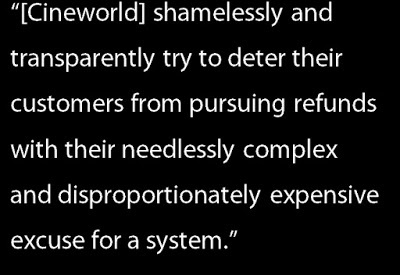 Rather than cut my losses, and desperately wanting to reward a brave and, by that time, scabby pock-marked little girl with a cinema trip, I eventually rebooked for 14th July 2015. Having watched the film (and the preceding forty-five minutes of adverts and trailers, which my daughter only sat through because she was still lacking her usual lustre... but that’s another rant for another day), I telephoned the 0871 number again. It took twenty-four minutes to speak to someone this time, with my call charges now easily exceeding a quarter of the refund that I was hoping to get. The operative that I spoke to told me that he couldn’t process the refund as they were in the process of moving the call centre “to another country” (he wouldn’t say which) and the system kept crashing. He took my mobile number and undertook to call me back the following day to confirm that the refund had been issued. He never did.
Rather than cut my losses, and desperately wanting to reward a brave and, by that time, scabby pock-marked little girl with a cinema trip, I eventually rebooked for 14th July 2015. Having watched the film (and the preceding forty-five minutes of adverts and trailers, which my daughter only sat through because she was still lacking her usual lustre... but that’s another rant for another day), I telephoned the 0871 number again. It took twenty-four minutes to speak to someone this time, with my call charges now easily exceeding a quarter of the refund that I was hoping to get. The operative that I spoke to told me that he couldn’t process the refund as they were in the process of moving the call centre “to another country” (he wouldn’t say which) and the system kept crashing. He took my mobile number and undertook to call me back the following day to confirm that the refund had been issued. He never did.
 On 17th July I telephoned again and spent another fifteen minutes queuing before speaking with Sophie, who said that “it looked like” the refund had been made on 14th July 2015 following my conversation with her colleague. I pointed out that this wasn’t sufficient and that I wanted her to check and confirm that the refund had been sent. She put me on hold for an unconvincing twenty to thirty seconds before confirming absolutely categorically positively that the refund had been sent and would be in my account within five days of 14th July 2015.
On 17th July I telephoned again and spent another fifteen minutes queuing before speaking with Sophie, who said that “it looked like” the refund had been made on 14th July 2015 following my conversation with her colleague. I pointed out that this wasn’t sufficient and that I wanted her to check and confirm that the refund had been sent. She put me on hold for an unconvincing twenty to thirty seconds before confirming absolutely categorically positively that the refund had been sent and would be in my account within five days of 14th July 2015.
 Guess what?
Guess what?
It wasn’t.
This evening I’ve just spoken with another unhelpful (but this time, at least honest) call centre operative who told me that the whole system was falling apart in the migration from the UK to overseas and that the best he could advise me was to write a strongly-worded e-mail to customer.services@cineworld.co.uk (an e-mail address that’s closely guarded, for obvious reasons). You’re reading it.
Never again will I book in advance to see a movie at Cineworld; never again will I even frequent Cineworld - not unless they issue me with a refund together with some form of recompense, anyway. I’ve incurred around £12.00 in call charges chasing a £20.31 refund which could have been avoided altogether had Cineworld incorporated a simple “cancel / amend booking” feature in their online booking system rather than shamelessly and transparently try to deter their customers from pursuing refunds with their needlessly complex and disproportionately expensive excuse for a system.
Love film? Hate Cineworld.
I’m generally reluctant to book things in advance for fear of things like this, but as Cineworld offer slightly discounted prices for online bookings, I decided to make an exception. And so on 4th July 2015 I booked three tickets to see Minions the following afternoon as a treat for my three-year-old daughter. She’d been watching the trailers religiously on YouTube and couldn’t have been more excited about it.
 On 5th July 2015, she woke up covered in chickenpox. I logged into my Cineworld account online to find, to my surprise, that I couldn’t simply amend my booking, let alone cancel it. I found this shocking given the otherwise in-depth nature of the booking system, which even allows whoever is booking to select their seats in advance. Annoyed, I telephoned 0333 00 33 444 – the telephone number at the bottom of my e-mail confirmation (see left-hand e-mail below) – and instantly incurred a 10p charge, only to be immediately told to redial on 0871 200 2000, charged at 12p per minute. It then took nearly fifteen minutes to get through to someone, by which time I’d incurred call charges of around £1.90 overall.
On 5th July 2015, she woke up covered in chickenpox. I logged into my Cineworld account online to find, to my surprise, that I couldn’t simply amend my booking, let alone cancel it. I found this shocking given the otherwise in-depth nature of the booking system, which even allows whoever is booking to select their seats in advance. Annoyed, I telephoned 0333 00 33 444 – the telephone number at the bottom of my e-mail confirmation (see left-hand e-mail below) – and instantly incurred a 10p charge, only to be immediately told to redial on 0871 200 2000, charged at 12p per minute. It then took nearly fifteen minutes to get through to someone, by which time I’d incurred call charges of around £1.90 overall. The spectacularly unhelpful call centre operative that I’d waited so long to speak to told me that the booking couldn’t be amended, and that I’d have to hang up; log back into the website; and make a fresh booking before calling back with both booking reference numbers so that the original booking could be refunded. Why this initial call-avoiding information couldn’t be set out in the booking confirmation e-mail, I have no idea; I can only speculate that there’s money to be made in getting punters to make a needless call.

Struggling to suppress my anger, I politely hung up and logged into the website, where I discovered that bookings could only be made up to the middle of the week, at which time my little girl would still be quarantined. I called back, waited nearly twenty minutes – so we’re up to at least £4.00 in call charges by now – and, despite being almost apoplectic with rage, managed to politely explain the situation to another call centre operative, Lucas. As kindly as I could, I then expressed my grievance with his colleague who plainly didn’t listen to a word that I’d said when I’d explained that we wouldn’t be able to come to the cinema for at least 7-10 days, lest my daughter infect others. Lucas reassured me that as long as the tickets were not collected, they could still be refunded for up to 45 days following the original scheduled performance - I didn’t need to rebook immediately. All of this information could have been set out in the booking confirmation e-mail, thus avoiding my first two calls.
 Rather than cut my losses, and desperately wanting to reward a brave and, by that time, scabby pock-marked little girl with a cinema trip, I eventually rebooked for 14th July 2015. Having watched the film (and the preceding forty-five minutes of adverts and trailers, which my daughter only sat through because she was still lacking her usual lustre... but that’s another rant for another day), I telephoned the 0871 number again. It took twenty-four minutes to speak to someone this time, with my call charges now easily exceeding a quarter of the refund that I was hoping to get. The operative that I spoke to told me that he couldn’t process the refund as they were in the process of moving the call centre “to another country” (he wouldn’t say which) and the system kept crashing. He took my mobile number and undertook to call me back the following day to confirm that the refund had been issued. He never did.
Rather than cut my losses, and desperately wanting to reward a brave and, by that time, scabby pock-marked little girl with a cinema trip, I eventually rebooked for 14th July 2015. Having watched the film (and the preceding forty-five minutes of adverts and trailers, which my daughter only sat through because she was still lacking her usual lustre... but that’s another rant for another day), I telephoned the 0871 number again. It took twenty-four minutes to speak to someone this time, with my call charges now easily exceeding a quarter of the refund that I was hoping to get. The operative that I spoke to told me that he couldn’t process the refund as they were in the process of moving the call centre “to another country” (he wouldn’t say which) and the system kept crashing. He took my mobile number and undertook to call me back the following day to confirm that the refund had been issued. He never did. On 17th July I telephoned again and spent another fifteen minutes queuing before speaking with Sophie, who said that “it looked like” the refund had been made on 14th July 2015 following my conversation with her colleague. I pointed out that this wasn’t sufficient and that I wanted her to check and confirm that the refund had been sent. She put me on hold for an unconvincing twenty to thirty seconds before confirming absolutely categorically positively that the refund had been sent and would be in my account within five days of 14th July 2015.
On 17th July I telephoned again and spent another fifteen minutes queuing before speaking with Sophie, who said that “it looked like” the refund had been made on 14th July 2015 following my conversation with her colleague. I pointed out that this wasn’t sufficient and that I wanted her to check and confirm that the refund had been sent. She put me on hold for an unconvincing twenty to thirty seconds before confirming absolutely categorically positively that the refund had been sent and would be in my account within five days of 14th July 2015. Guess what?
Guess what? It wasn’t.
This evening I’ve just spoken with another unhelpful (but this time, at least honest) call centre operative who told me that the whole system was falling apart in the migration from the UK to overseas and that the best he could advise me was to write a strongly-worded e-mail to customer.services@cineworld.co.uk (an e-mail address that’s closely guarded, for obvious reasons). You’re reading it.
Never again will I book in advance to see a movie at Cineworld; never again will I even frequent Cineworld - not unless they issue me with a refund together with some form of recompense, anyway. I’ve incurred around £12.00 in call charges chasing a £20.31 refund which could have been avoided altogether had Cineworld incorporated a simple “cancel / amend booking” feature in their online booking system rather than shamelessly and transparently try to deter their customers from pursuing refunds with their needlessly complex and disproportionately expensive excuse for a system.
Love film? Hate Cineworld.
Published on July 22, 2015 11:56
July 14, 2015
Fantastic Facts #2 | Red Dwarf
The search for the Solar System’s ninth planet began in 1906, when a wealthy Bostonian funded the “Planet X” project that, during the first year of the Great War, yielded the first dim images of what an eleven-year-old schoolgirl would eventually name Pluto. It wouldn’t be until almost fifteen years later that Planet X’s Clyde Tombaugh would obtain photographs confirming the celestial body’s movement, and the discovery of a ninth planet in our Solar System would be announced to the world.
And now, a century on from Pluto’s first faint appearance on the Lowell Observatory’s surveys, its discoverer’s ashes are flying within 8,000 miles of it aboard an unmanned NASA probe that promises to lift the veil on the Solar System’s most divergent and controversial known object.
 “We’re going to turn points of light
“We’re going to turn points of light
into a planet and a system
of moons before your eyes.”
– Alan Stern, NASA New Horizons
Since its discovery, Pluto has grown ever smaller in the eyes of humanity. Estimates of its mass and size have dwindled enormously over the decades, from around the same mass as Earth in 1930 to what we now know to be just 0.002 Earths (just under a fifth the mass of the Moon, if that’s easier to imagine). This makes Pluto a golf ball when compared to a football Earth, and, as it orbits the Sun forty times farther out than Earth, one that’s always between fifty and eighty miles away. Until now, studying it has been like trying to read a 12-point font on a piece of paper miles away. Squinting isn’t the half of it.
Moreover, following the discovery of what was initially reported as “The Tenth Planet”, Eris, in 2005, the International Astronomical Union (“IAU”) opted to withdraw Pluto’s planetary status rather than grant the same to Eris, in so doing stealing away not only our new tenth planet, but our long-established ninth too. They accomplished this by introducing a three-fold test for planethood: firstly, a planet must orbit its sun; secondly, it must have sufficient mass for gravity to have forced it into a spheroid or ellipsoid shape; and thirdly, it must have “cleared the neighbourhood around its orbit”. In practical terms, this means that it has to have become sufficiently gravitationally dominant to have either cleared away all bodies of comparable size from its orbit zone, or drawn them into its own orbit. Eris, Pluto and the other trans-Neptunian objects in the crowded Kuiper belt cannot satisfy this final criterion, and so find themselves labelled “dwarf planets” or “plutoids”.
Pluto’s reclassification has divided both the astronomical community and lay folk alike. With potentially hundreds of other dwarf planets awaiting discovery in the Kuiper belt, it’s easy to see why the IAU drew a line in the sand when and where they did. Conversely, tearing apart the “Classical Solar System” and thus ruining Robert Holmes’ seminal Doctor Who serial The Sun Makers was unquestionably going to piss people off - particularly when the contrived third criterion focuses on orbital characteristics as opposed to intrinsic ones, and potentially even casts doubt on other planets’ classifications (there’s quite an asteroid belt in Mars’ neighbourhood...) The ensuing contention hasn’t been helped by a lack of clarity when it comes to classifying dwarf planets either; only five are recognised presently, despite claims by astronomers such as Mike Brown, discoverer of Eris, that many other celestial bodies meet the IAU’s criteria.
None of this pigeon-holing, though, should undermine the significance of Pluto in our Solar System or the magnitude of the New Horizons probe’s exploration of it. After all, with a confirmed diameter of 1,473 miles, Pluto is still the largest and second most massive known dwarf planet in the Solar System. The distinction between “largest” and “most massive” might be lost on some readers, but it’s quite literally as it sounds: Pluto is physically larger than Eris (more voluminous, if you will), but Eris is more dense (it has around 27% greater mass). Its axis is tilted too, so like Uranus it seems to spin on its side. It also also boasts an impressive array of moons – Styx, Nix, Kerberos and Hydra – as well as Charon, which is either another satellite or a binary dwarf planet depending on who you ask. Many contend that Pluto and Charon are so close that their gravitational interaction causes them to orbit about a common centre of mass, rather than Charon orbiting Pluto as the Moon does Earth. They are even thought to be tidally locked, so if you could stand on Pluto, Charon would seem to hang perpetually in the sky. Accordingly, I’m particularly interested to see what light New Horizons can shed on Charon and its unusual relationship with the Classical ninth planet.
Probably my favourite thing about Pluto though is its chaotic orbit around the Sun, which differs from all of the other planets in the Classical Solar System. The eight planets’ orbits are broadly circular, while Pluto’s is elliptical, allowing it to come closer to the Sun than Neptune, effectively overtaking it for twenty years at a time. That’s not bad going for a planet that takes a leisurely quarter-millennium to orbit its star. Such a sweeping orbit must have repercussions for its atmosphere too – as the world moves further away from the Sun, its atmosphere probably freezes, with the ice turning back to gas as it draws nearer again. This being the case, what New Horizons shows us will probably only be a snapshot of Pluto as it is at this particular phase of its orbit, but it promises to be one from which many inferences can reasonably be drawn.
Torturously, we’ll have to wait sixteen months for NASA to receive all of the New Horizons probe’s priceless data as not only does it take the data the better part of five hours to traverse the three billion or so miles separating it from Earth, but even NASA’s two-hundred-foot-wide radio dishes can only receive it at a rate of about a kilobyte per second – a rate of transfer that my mid-1990s modem would have been embarrassed about. It certainly pulls into sharp focus just how near your closest broadband exchange really is.
 However, even though we’re still hours away from receiving the first data from the (fittingly) plutonium-powered probe’s fleeting flyby, we already know far more about the last unexplored world orbiting the Sun than we did a week ago. The icy plutoid isn’t the greyscale sphere that many had assumed; it’s a gorgeous tapestry of red, orange and even black – quite fitting, really, for a world named after the god of the underworld. Its terrain is correspondingly varied, encompassing mountains and valleys that are redolent of Mars together with craters which evoke familiar images of our own planet’s moon. Other areas appear smooth, perhaps betraying the sphere’s relative youth or geological activity; maybe even both. What I found most interesting, though, is the notion that the dwarf planet’s thin nitrogen atmosphere allows for the possibility of snow, some three billion miles away from the nearest snowman…
However, even though we’re still hours away from receiving the first data from the (fittingly) plutonium-powered probe’s fleeting flyby, we already know far more about the last unexplored world orbiting the Sun than we did a week ago. The icy plutoid isn’t the greyscale sphere that many had assumed; it’s a gorgeous tapestry of red, orange and even black – quite fitting, really, for a world named after the god of the underworld. Its terrain is correspondingly varied, encompassing mountains and valleys that are redolent of Mars together with craters which evoke familiar images of our own planet’s moon. Other areas appear smooth, perhaps betraying the sphere’s relative youth or geological activity; maybe even both. What I found most interesting, though, is the notion that the dwarf planet’s thin nitrogen atmosphere allows for the possibility of snow, some three billion miles away from the nearest snowman…
 Enjoy the coming days and months, space fans, because once New Horizons passes through the Kuiper belt, it’s going to be many lifetimes before it reaches another world, let alone one with all the quirks and caprices of Pluto.
Enjoy the coming days and months, space fans, because once New Horizons passes through the Kuiper belt, it’s going to be many lifetimes before it reaches another world, let alone one with all the quirks and caprices of Pluto.
And now, a century on from Pluto’s first faint appearance on the Lowell Observatory’s surveys, its discoverer’s ashes are flying within 8,000 miles of it aboard an unmanned NASA probe that promises to lift the veil on the Solar System’s most divergent and controversial known object.
 “We’re going to turn points of light
“We’re going to turn points of lightinto a planet and a system
of moons before your eyes.”
– Alan Stern, NASA New Horizons
Since its discovery, Pluto has grown ever smaller in the eyes of humanity. Estimates of its mass and size have dwindled enormously over the decades, from around the same mass as Earth in 1930 to what we now know to be just 0.002 Earths (just under a fifth the mass of the Moon, if that’s easier to imagine). This makes Pluto a golf ball when compared to a football Earth, and, as it orbits the Sun forty times farther out than Earth, one that’s always between fifty and eighty miles away. Until now, studying it has been like trying to read a 12-point font on a piece of paper miles away. Squinting isn’t the half of it.
Moreover, following the discovery of what was initially reported as “The Tenth Planet”, Eris, in 2005, the International Astronomical Union (“IAU”) opted to withdraw Pluto’s planetary status rather than grant the same to Eris, in so doing stealing away not only our new tenth planet, but our long-established ninth too. They accomplished this by introducing a three-fold test for planethood: firstly, a planet must orbit its sun; secondly, it must have sufficient mass for gravity to have forced it into a spheroid or ellipsoid shape; and thirdly, it must have “cleared the neighbourhood around its orbit”. In practical terms, this means that it has to have become sufficiently gravitationally dominant to have either cleared away all bodies of comparable size from its orbit zone, or drawn them into its own orbit. Eris, Pluto and the other trans-Neptunian objects in the crowded Kuiper belt cannot satisfy this final criterion, and so find themselves labelled “dwarf planets” or “plutoids”.
Pluto’s reclassification has divided both the astronomical community and lay folk alike. With potentially hundreds of other dwarf planets awaiting discovery in the Kuiper belt, it’s easy to see why the IAU drew a line in the sand when and where they did. Conversely, tearing apart the “Classical Solar System” and thus ruining Robert Holmes’ seminal Doctor Who serial The Sun Makers was unquestionably going to piss people off - particularly when the contrived third criterion focuses on orbital characteristics as opposed to intrinsic ones, and potentially even casts doubt on other planets’ classifications (there’s quite an asteroid belt in Mars’ neighbourhood...) The ensuing contention hasn’t been helped by a lack of clarity when it comes to classifying dwarf planets either; only five are recognised presently, despite claims by astronomers such as Mike Brown, discoverer of Eris, that many other celestial bodies meet the IAU’s criteria.
None of this pigeon-holing, though, should undermine the significance of Pluto in our Solar System or the magnitude of the New Horizons probe’s exploration of it. After all, with a confirmed diameter of 1,473 miles, Pluto is still the largest and second most massive known dwarf planet in the Solar System. The distinction between “largest” and “most massive” might be lost on some readers, but it’s quite literally as it sounds: Pluto is physically larger than Eris (more voluminous, if you will), but Eris is more dense (it has around 27% greater mass). Its axis is tilted too, so like Uranus it seems to spin on its side. It also also boasts an impressive array of moons – Styx, Nix, Kerberos and Hydra – as well as Charon, which is either another satellite or a binary dwarf planet depending on who you ask. Many contend that Pluto and Charon are so close that their gravitational interaction causes them to orbit about a common centre of mass, rather than Charon orbiting Pluto as the Moon does Earth. They are even thought to be tidally locked, so if you could stand on Pluto, Charon would seem to hang perpetually in the sky. Accordingly, I’m particularly interested to see what light New Horizons can shed on Charon and its unusual relationship with the Classical ninth planet.
Probably my favourite thing about Pluto though is its chaotic orbit around the Sun, which differs from all of the other planets in the Classical Solar System. The eight planets’ orbits are broadly circular, while Pluto’s is elliptical, allowing it to come closer to the Sun than Neptune, effectively overtaking it for twenty years at a time. That’s not bad going for a planet that takes a leisurely quarter-millennium to orbit its star. Such a sweeping orbit must have repercussions for its atmosphere too – as the world moves further away from the Sun, its atmosphere probably freezes, with the ice turning back to gas as it draws nearer again. This being the case, what New Horizons shows us will probably only be a snapshot of Pluto as it is at this particular phase of its orbit, but it promises to be one from which many inferences can reasonably be drawn.
Torturously, we’ll have to wait sixteen months for NASA to receive all of the New Horizons probe’s priceless data as not only does it take the data the better part of five hours to traverse the three billion or so miles separating it from Earth, but even NASA’s two-hundred-foot-wide radio dishes can only receive it at a rate of about a kilobyte per second – a rate of transfer that my mid-1990s modem would have been embarrassed about. It certainly pulls into sharp focus just how near your closest broadband exchange really is.
 However, even though we’re still hours away from receiving the first data from the (fittingly) plutonium-powered probe’s fleeting flyby, we already know far more about the last unexplored world orbiting the Sun than we did a week ago. The icy plutoid isn’t the greyscale sphere that many had assumed; it’s a gorgeous tapestry of red, orange and even black – quite fitting, really, for a world named after the god of the underworld. Its terrain is correspondingly varied, encompassing mountains and valleys that are redolent of Mars together with craters which evoke familiar images of our own planet’s moon. Other areas appear smooth, perhaps betraying the sphere’s relative youth or geological activity; maybe even both. What I found most interesting, though, is the notion that the dwarf planet’s thin nitrogen atmosphere allows for the possibility of snow, some three billion miles away from the nearest snowman…
However, even though we’re still hours away from receiving the first data from the (fittingly) plutonium-powered probe’s fleeting flyby, we already know far more about the last unexplored world orbiting the Sun than we did a week ago. The icy plutoid isn’t the greyscale sphere that many had assumed; it’s a gorgeous tapestry of red, orange and even black – quite fitting, really, for a world named after the god of the underworld. Its terrain is correspondingly varied, encompassing mountains and valleys that are redolent of Mars together with craters which evoke familiar images of our own planet’s moon. Other areas appear smooth, perhaps betraying the sphere’s relative youth or geological activity; maybe even both. What I found most interesting, though, is the notion that the dwarf planet’s thin nitrogen atmosphere allows for the possibility of snow, some three billion miles away from the nearest snowman… Enjoy the coming days and months, space fans, because once New Horizons passes through the Kuiper belt, it’s going to be many lifetimes before it reaches another world, let alone one with all the quirks and caprices of Pluto.
Enjoy the coming days and months, space fans, because once New Horizons passes through the Kuiper belt, it’s going to be many lifetimes before it reaches another world, let alone one with all the quirks and caprices of Pluto.
Published on July 14, 2015 15:41
E.G. Wolverson's Blog
- E.G. Wolverson's profile
- 52 followers
E.G. Wolverson isn't a Goodreads Author
(yet),
but they
do have a blog,
so here are some recent posts imported from
their feed.



